-
Coulomb coupling between moire mini-band and massless Dirac band
Caption: Coulomb drag in graphene-hBN-graphene moiré heterostructures. (a) Schematics of device with top graphene aligned with h-BN to form moiré patterns. (b) The color-plot of drag resistivity as a function of charge densities of the top and bottom graphene, Pdrag(nT,nB). The plot clearly shows drag effect in regions where the Fermi energy of the top graphene is near the satellite Dirac points (regions II and III). Adopted from Phys. Rev. Lett. 133, 186301 (2024).Coulomb drag experiment can be used to investigate interlayer Coulomb interaction between different electronic systems which otherwise cannot be coupled with. Here, by building graphene-hBN-graphene ré heterostructures and measuring finite drag resistances, we show that charge carriers in moiré mini-bands can be coupled with massless Dirac fermions in original graphene even though the reciprocal lattice sizes are nearly two orders of magnitude different. Our work demonstrates that one can couple moiré and non-moiré bands using drag experiment and further investigate how such interlayer Coulomb interactions affect the electronic properties. Having seen a rapid progress in moiré physics, we believe our study opens an interesting venue to explore new interactions effects in diverse moiré systems. This work is published on Phys. Rev. Lett. 133, 186301 (2024).
-
High-harmonic spectroscopy probes lattice dynamics
Caption:a, Schematic of the experimental set-up: two ultrashort laser pulses with centre wavelengths at 800 nm (pump ~30 fs) and 400 nm (probe ~25 fs) are used to form a non-collinear pump-probe HHG detection geometry. The HHG spectra from both the pump and probe are recorded by an EUV spectrometer placed downstream of the sample. b, Optical excitation and e-ph interaction scheme in the electron bandstructure. Red, blue and violet waves and arrows show the pump excitation, probe excitation and THG emission, respectively. Green and yellow waves represent the phonon creation and scattering. The backaction of the phonons leads to modulations of the electron bands (green arrows). c, Detected lattice vibrations from the time-delayed THG spectrum of the probe. Adopted from Nature Photonics 18, 792-798 (2024).The probing of coherent lattice vibrations in solids has been conventionally carried out using time-resolved transient spectroscopy where only the relative oscillation amplitude can be obtained. Using time-resolved X-ray techniques, absolute electron-phonon coupling strength could be extracted. However, the complexity of such an experiment renders it impossible to be carried out in conventional laboratories. Here we demonstrate that the electron-phonon, anharmonic phonon-phonon coupling, and their relaxation dynamics can be probed in real-time using high-harmonic spectroscopy. Our technique is background-free and has extreme sensitivity directly in the energy domain. In combination with the optical deformation potential calculated from density functional perturbation theory and the absolute energy modulation depth, our measurement reveals the maximum displacement of neighboring oxygen atoms in a-quartz crystal to tens of picometers in real space. By employing a straightforward and robust time-windowed Gabor analysis for the phonon-modulated high-harmonic spectrum, we successfully observe channel-resolved four-phonon scattering processes in such highly nonlinear interactions. Our work opens a new realm for accurate measurement of coherent phonons and their scattering dynamics, which allows for potential benchmarking ab-initio calculations in solids. While the initial demonstration has used bulk solids, there is a strong potential in application of this technique to 2D materials. Our technique allows detection of coherent phonon dynamics with an extremely large range of available frequencies, with very high sensitivity. Furthermore, especially for 2D materials, our technique allows direct comparison between experimental observables and ab-initio calculations of electron-phonon couplings. The ability of tracing coherent phonon dynamics and how the phonon relaxations (building up a given phonon frequency while diminishing the other phonon frequencies) happen in real time is truly unique. Our technique is very robust. It worked on all materials we tested so far. The rigidity of this technique is especially suited for research on 2D materials because it really helps us to focus on the materials, not worrying at all about the technique itself. This work is published on Nature Photonics 18, 792-798 (2024).
-
The light induced material deposition (LIMD) method won gold medal in International Exhibition of Inventions Geneva
Caption: (left) Prototype machine of direct laser writing system. (middle) Patterns wrote with light induced material deposition (LIMD) method in gold and platinum. The blue scale bar represents 25 micron. The invention was developed by Sen Yang, Zeying Chen, Yifan Chen, Wing Ki Lo.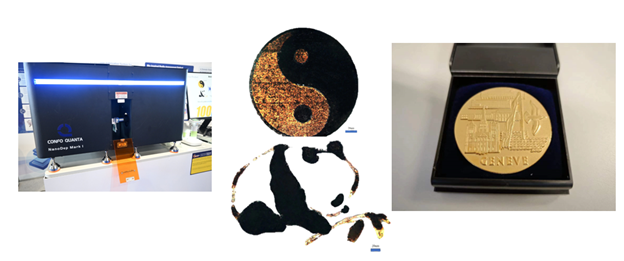
The foundation of high-performance chip manufacturing lies in the precise patterning of microscale and nanoscale material structures. Currently, the predominant technique utilized is photolithography, which involves a complex series of steps including spin coating of photoresist, positioning, exposure, developing, evaporation deposition, electroplating, and lift-off processes. These procedures must be executed in a meticulously clean environment and require costly equipment such as mask aligners and vapor deposition machines. In light of these challenges, we have proposed and developed a groundbreaking technology known as single-step laser direct writing. This innovative method combines two key elements: laser-induced optical trapping and light-induced chemical reduction reactions. By preparing an "ink" and utilizing a regular confocal laser scanning microscope platform, we are able to achieve high-precision material deposition in a single step. This approach offers significant simplification to the fabrication of electronics, particularly in the production of chips and flexible devices incorporating 2D materials.
-
New type of quantum phase transition in 2D interacting Dirac electrons beyond Landau-Ginzburg paradigm
Caption: Using nonlocal probes such as the disorder operator and entanglement entropy, we reveal that the symmetric mass generation is an unconventional quantum phase transition beyond the traditional paradigm, and it corresponds to a true 2+1d conformal filed theory. The model and computation are performed on a honeycomb lattice and with electronic interaction which might be found in quantum moire material. Adopted from Phys. Rev. Lett. 132.156503 (2024).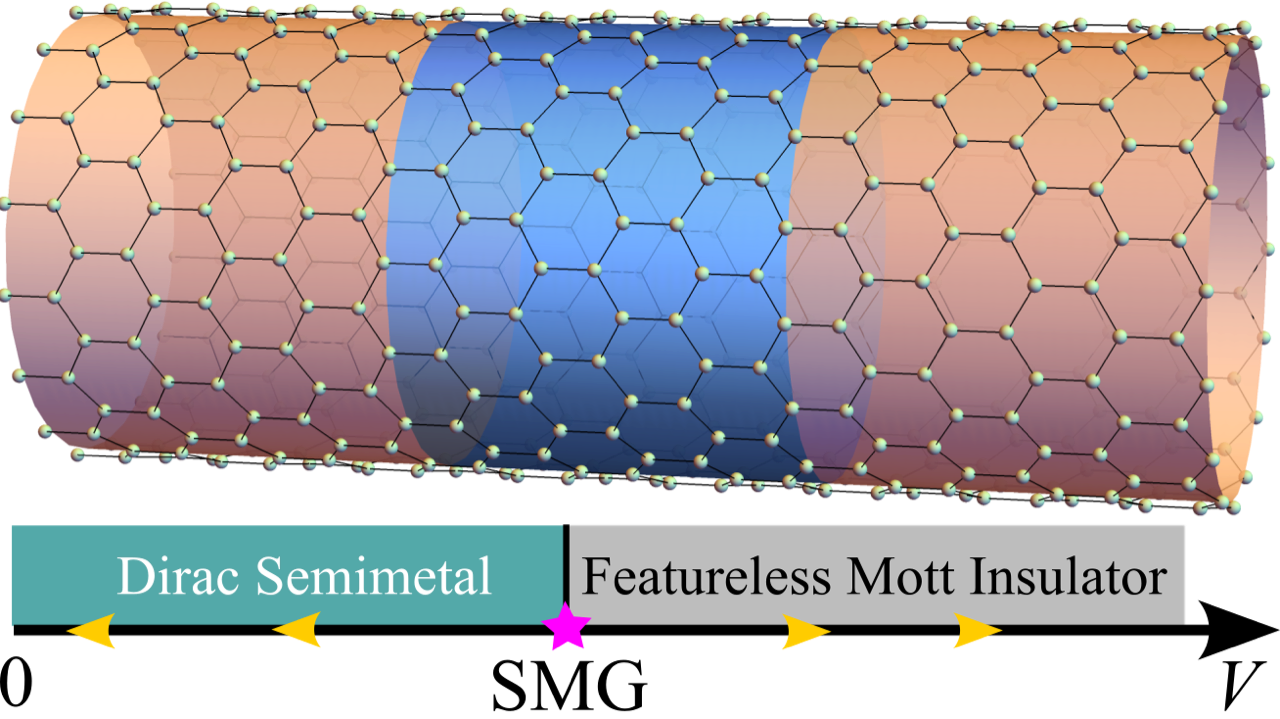
For 2D interacting electrons such as those in twisted bilayer graphene and transition metal dichalcogenides, the normal fate upon changing the control parameters such as gating, twisted angle and electronic and magnetic fields, is to go through phase transitions to various symmetry-breaking phases, such as superconducting, charge-density wave or (fractional) Chern insulator phases. However, is there the possibility that the Dirac fermions in such systems can go into insulating phase without invoking the traditional path of spontaneous symmetry breaking? The answer is affirmative and such transition is coined as symmetric mass generation (SMG). SMG is discovered in recent years has attracted great interest from both condensed matter and high energy theory communities. During the SMG transition, the interacting Dirac electrons acquire a gap without any concomitant spontaneous symmetry breaking, and it is hence beyond the conventional Landau-Ginzburg paradigm of phase transitions. One important question we address in this paper is whether the SMG transition corresponds to a true unitary conformal field theory. We employ the sharp diagnosis including the scaling of disorder operator and Rényi entanglement entropy in large-scale lattice model quantum Monte Carlo simulations. Our results strongly suggest that the SMG transition is indeed an unconventional quantum phase transition and it should correspond to a true (2+1)d unitary conformal field theory. With our findings, the strongly correlated electrons in 2D quantum re materials, will have a new destiny, awaiting to be further explored both theoretically and experimentally.
-
Ballistic transport spectroscopy of spin-orbit-coupled bands in monolayer graphene on WSe₂
Caption: Ballistic transverse magnetic focusing (TMF) in graphene-WSe2 heterostructures. (a) Sample characteristics and measurement scheme. (b) TMF spectroscopy that shows the splitting of the first focusing peak in a good agreement with calculation using the spin-orbit-coupling strength of 13.9 meV. Inset: carrier trajectories for the first and second focusing peaks (top left and bottom right, respectively). Adopted from Nature Communications 14, 6124 (2023).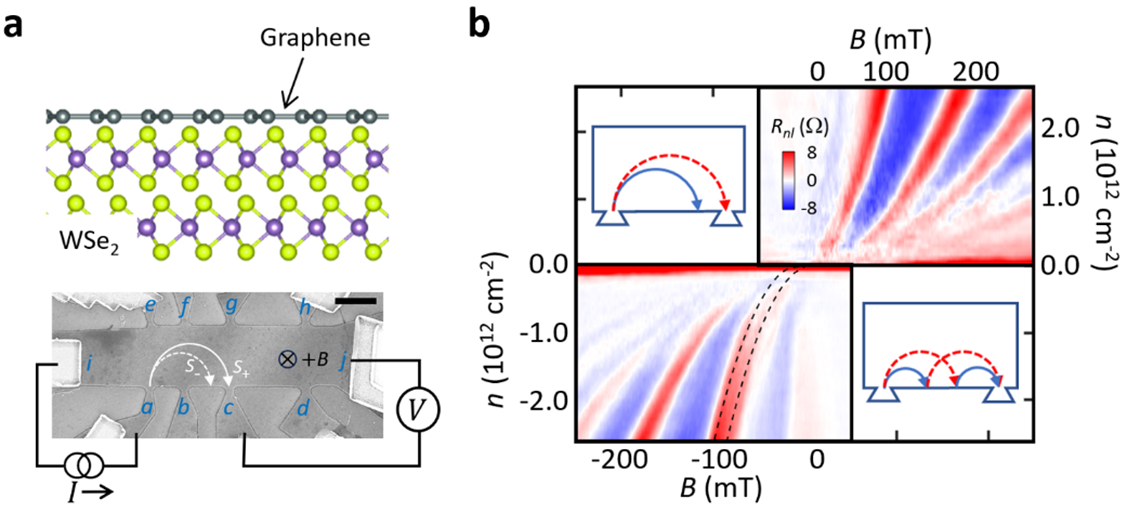
Spin-orbit coupling (SOC) provides unique capabilities to control spin by moving electrons around or turn electron trajectories by rotating spin. Here we show that using WSe2 as a substrate, one can induce strong SOC in graphene while simultaneously achieving ballistic transport where electron trajectories can be tuned by external parameters such as magnetic fields. We demonstrate this by measuring ballistic transverse magnetic focusing (TMF) from which we find the spectroscopic evidence of the large SOC strength, ~13 meV, in the system and probe electron dynamics that are sensitive to the edge scattering and temperature. Our study illustrates, unambiguously, that it is now possible to exploit a variety of highly-tunable ballistic transport effects in graphene, such as TMF, Veselago lensing, Fabry-Pérot interference, and more, to control or detect spin by turning ballistic electron motion. This adds graphene van der Waals heterostructures as one of the promising material platforms in the field of ballistic spin-orbitronics. This work is published on Nature Communications 14, 6124 (2023).
-
Intrinsic Nonlinear Hall Effect and Gate-Switchable Berry Curvature Sliding in Twisted Bilayer Graphene
Caption: Second harmonic Hall effect tunable with vertical electric field and filling in 1.30° twisted bilayer graphene (TBG). (a) Measured second harmonic Hall voltage. (b) Calculated Berry curvature dipole Λ≡∑n∫k∂ƒ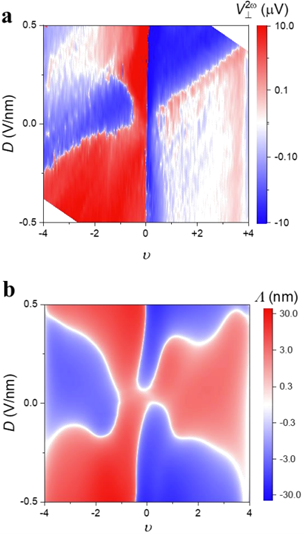
0 Ωn with 0.3% uniaxial strain. Adopted from Supplemental Material of Phys. Rev. Lett. 131, 066301 (2023).Berry curvature, which is usually cumulated at band edge, is believed to contribute to anomalous velocity as well as anomalous transport (i.e., beyond Drude model). Commonly, distribution of Berry curvature is stable within dispersive bands if there is no gap close-reopen topological phase transition. This means anomalous transport should not be sensitive to perturbation of bands dispersion. However, this is not the case within topological flat bands. In TBG away from ‘magic angle‘ , the bands near charge neutrality are less dispersive and the correlation effect does not dominate. Here, we find the second harmonic Hall effect is sensitive to the sliding Berry curvature under tuning of vertical electric field. As shown in the figure above, numerical calculation (b) matches well with the experimental observation (a). Our results confirm nonlinear Hall effect can be used to detect Berry curvature redistribution without gap close-reopen in topological flat bands and ‘non-magic angle‘ TBG is a suitable platform for observing such a phenomenon. This work is published on Phys. Rev. Lett. 131, 066301 (2023).
-
Time Reversal Even Charge Hall Effect from Twisted Interface Coupling
Caption: Time reversal even Hall current (red arrow) from twisted interfacial coupling with an environmental layer (gray surface). A counterflow Hall current is expected in the latter, by Onsager relation on the whole structure: system (Sys) layer + environment (Env) layer. The TR-even Hall voltage due to charge accumulation at the sample edges can be detected with a layer-resolved measurement. Adopted from Nature Communications 14, 1961 (2023).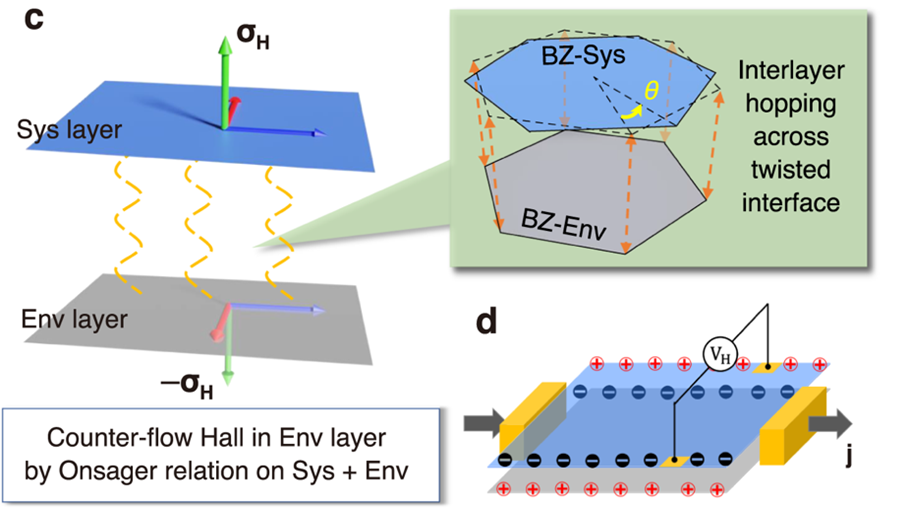
Hall effect, by a genuine definition, is charge current of the form jH = σH x E, in linear response to an electric field E. It is long believed that Hall effect is limited to systems with broken time reversal symmetry. All known contributions to the Hall conductivity σH transform odd under time reversal operation, with origin either from magnetic field or magnetic order. An evenly transformed σH (i.e., invariant) under time reversal operation is forbidden by the delicate Onsager reciprocal relation governing the linear responses. A fact often overlooked, however, is that Onsager relation was originally derived for isolated systems. In this work, we show the first scenario of having time reversal even charge Hall effect in a non-isolated system with time reversal symmetry. In absence of magnetic field or magnetic order, a structural chirality is required instead to comply with the nature of Hall current. These necessary conditions are naturally fulfilled in twisted van der Waals layered structures, where a monolayer constitutes the non-isolated 2D system, coupled via electron quantum tunneling with adjacent layers constituting its environment. In twisted bilayer graphene and twisted homobilayer transition metal dichalcogenides with a broad range of twist angles, we show giant Hall currents counterflowing in the double layer geometry, with Hall voltages measurable in a layer-resolved Hall bar setup. This work is published on Nature Communications 14, 1961 (2023).
-
Ferroelectricity in untwisted heterobilayers of transition metal dichalcogenides
Caption: (A) The two stacking types of our MoS2/WS2 heterobilayer. They can be identified using SHG mapping. The 0° stacking type shows strong, (bright green) SHG emission, whereas the 180° type shows very weak (nearly black) SHG emission. (B) The piezoelectric phase can be switched by applying a sufficiently large voltage to the material. The corresponding piezoelectric deformation hysteresis loop forms the typical butterfly shape. (C) The FTJ built from our material can be put into a high/low electrical resistance state by applying sufficiently large voltage. Adopted from SCIENCE 376, 973 (2022).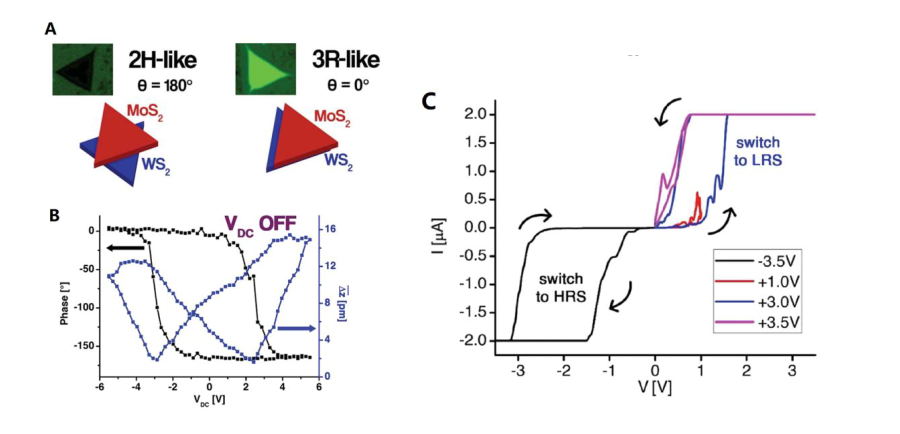
We show that ferroelectricity can arise from the interaction of two vertically stacked 2D material layers, specifically MoS2 and WS2, even without any formation of moiré structures. The two monolayer materials by themselves are not ferroelectric in nature. In virtue of their structural similarity, we could grow the two materials together commensurately in a simple one-step Chemical Vapour Deposition (CVD) process. This allows us to fabricate a large number of heterostructures at once without the need for high-precision transfer techniques. The stacking angle between the two layers comes exclusively in 0° and 180° from our bottom up approach, which are the two stacking types that don’t create moiré superstructures. We have identified the two types using Second-Harmonic Generation (SHG) mapping. The lack in vertical symmetry of the heterobilayer causes an internal polarization that allows for vertical piezoelectric deformation (~ 2 pmV-1). Moreover, a small amount of inter-layer sliding can reverse the internal polarization which leads to the appearance of ferroelectric switching. From the heterobilayer we built a simple Ferroelectric Tunnel Junction (FTJ) which can switch its electrical resistance magnitude based on prior poling. Our experimental output is supported by our Density Functional Theory (DFT) calculations that are based on a dual-slab model where the ferroelectric is sandwiched by two conductive electrodes, where the bottom electrode has strong, and the top electrode weak interaction with the MoS2/WS2 layer, in accordance with the actual experimental setup where the top electrode was a movable conductive AFM tip. This work was published on SCIENCE 376, 973 (2022). -
Chiral excitonics in 2D semiconductors on patterned dielectric superlattices
Caption: Caption: Nano-optical excitation can inject exciton flow with left-right directionality controlled by circular polarization and angular directionality controlled by location of the excitation. From Phys. Rev. Lett. 128, 217402 (2022).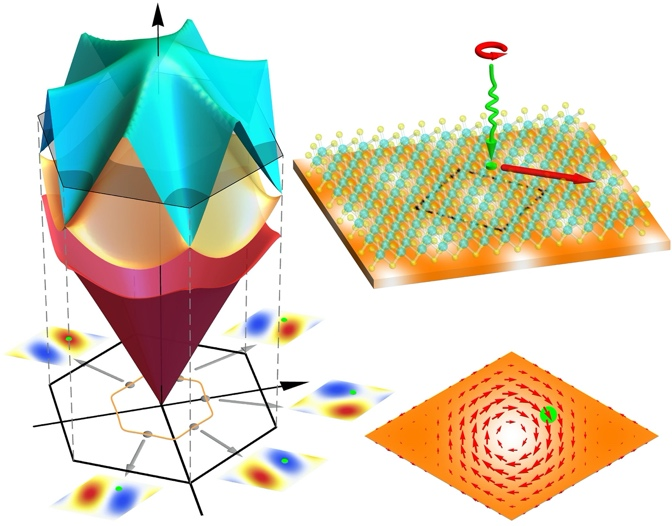
Spin-momentum locking of light in one-dimensional nanophotonic confinements, combined with circularly polarized emitters, constitutes a chiral light-matter interface that opens the door to a whole new realm of chiral optical phenomena of fundamental importance. Here we discover a chiral interface in two-dimension, with the role of light now played by valley exciton Bloch wave in a monolayer semiconductor placed on patterned dielectric substrate (such as photonic crystal slab). With the periodic dielectric spatially modulating the electron-hole Coulomb exchange strength, exciton Bloch bands form, where the wavefunctions feature spatial texture of valley pseudospin that is pattern-locked to the propagation direction. The mesoscopic periodicity of such texture makes possible nano-optical excitation of directional exciton flow through the valley selection rule. The left-right directionality of exciton current is controlled by the circular polarization of excitation, while the angular directionality in the 2D plane is controlled by the excitation location, exhibiting a vortex pattern in a supercell. It points to unprecedented opportunities to explore non-reciprocal exciton manipulations and functionalities in a readily available system. This work was published on Phys. Rev. Lett. 128, 217402 (2022). -
Exciton mediated ferromagnetism
Caption: Exciton mediated spin-spin interaction in moire superlattice (adopted from Nature 604, 468 (2022))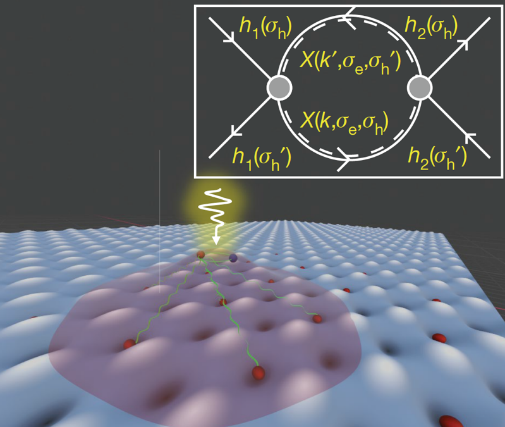
The ability to tune many-body interactions would enable access and control correlated phases of matter. This work discovers that optical excitation can drastically tune the spin-spin interactions between moiré trapped carriers in WS2/WSe2 moiré superlattices, and thus result in long-range ferromagnetic order, otherwise absent in the dark condition. In dilute hole doping regime, reflective magnetic circular dichroism (RMCD) signal emerges at zero magnetic field with the increase of optical excitation power. Above a small threshold excitation power, RMCD signal vs magnetic field shows clear hysteresis loops, signature of a ferromagnetic order. Temperature dependent RMCD shows enhanced critical temperature at certain fractional fillings where Mott-Wigner states form, suggesting the ferromagnetic order is further stabilized with the formation of charge order. With the increase of hole filling to v = -1, RMCD shows a super-paramagnetic like response instead. Our theoretical model finds that the spin-spin exchange interaction between moiré trapped holes can be greatly enhanced by optically excited excitons. This exciton-mediated ferromagnetic interaction is of longer range than direct coupling between moiré trapped holes, and thus magnetic order can arise even in the dilute hole regime under optical excitation. Using realistic experimental parameters, the calculated exchange interaction strength is consistent with the value extracted from temperature dependent measurements. This discovery adds a new and dynamic tuning knob to the rich many-body Hamiltonian of moiré quantum matter, which opens the possibility to access and control the complex electronic phase diagrams on demand. The work was published on Nature 604, 468 (2022). -
Bridging the gap between TMDCs and metals
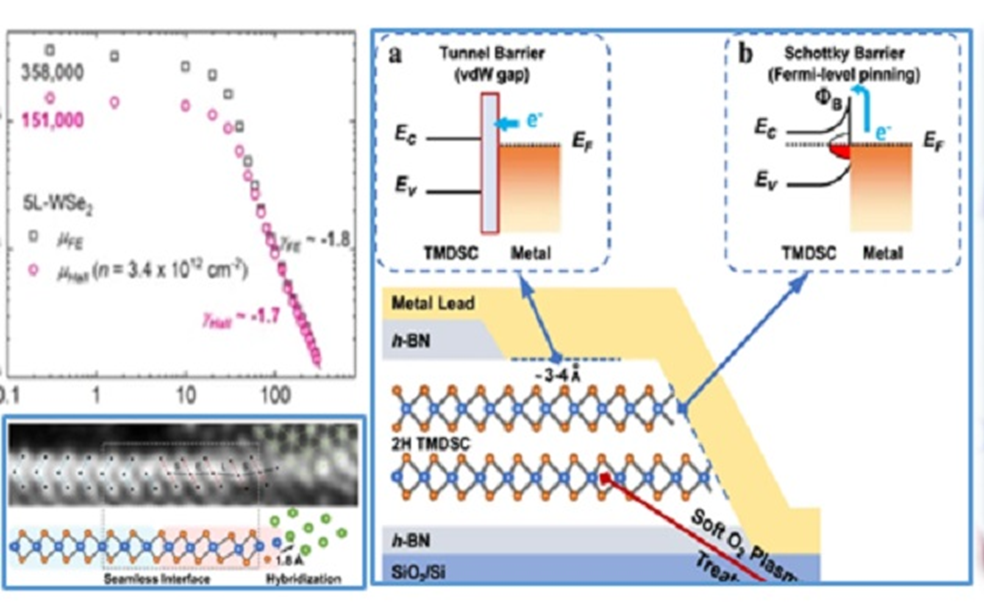
We developed a new strategy to achieve nearly barrier-free electrical contacts with few-layer TMDSCs. The carrier-injection efficiency is substantially increased with robust ohmic behaviors from room to cryogenic temperatures. We achieved ultra low contact resistance (down to 90 Ωµm in MoS2, towards the quantum limit) and ultra high field-effect mobility (up to 358,000 cm^2/Vs in WSe2). This work was published on Nat. Commun. 13, 1777 (2022). -
Valley-Polarized Quantum Anomalous Hall State in Moiré MoTe2/WSe2 Heterobilayers
Caption: The Berry curvature Ω(k) as a function of lattice momentum k in the moiré Brillouin zone. The Chern number C changes from 0 to 1 as the pseudo magnetic flux Φ of a moiré unit cell changes from 0 to 0.8 Φ0 where Φ0 denotes a flux quantum.
Two-dimensional moiré superlattices have emerged as an ideal system to study the many-body interactions and correlated states. Recently, the quantum anomalous Hall phase was observed in MoTe2/WSe2 heterobilayers at half-filling (one hole per moiré unit cell) [Nature 600, 641 (2021)]. However, the moiré heterobilayers can be treated as a monolayer MoTe2 under the periodic moiré potential induced by the WSe2 layer, and the electronic states are presumably to be topologically trivial. Therefore, the mechanism behind the emergence of the topological phase is not known. In this work, we propose that the topologically nontrivial phase can be induced by the pseudo-magnetic fields caused by lattice relaxation.
We point out that a periodically modulated pseudo-magnetic field breaks the intra-valley time-reversal symmetry and induce non-zero Chern numbers at each valley. At half-filling, the strong Coulomb interactions lift the valley degeneracy and induce a valley-polarized state, where the quantum anomalous Hall effect can be observed. Our theory identifies a new mechanism to achieve topologically nontrivial states and provides a basis for the study of other strongly correlated phases such as the fractional Chern insulating states in heterobilayer transition metal dichalcogenides. The work was published on Phys. Rev. Lett. 128, 026402 (2022). -
Computing quantum entanglement for 2D systems
Caption: New way to compute the quantum entanglement with the non-equilibrium increment (“Qiu Ku”) algorithm, with the help of a pair of pants – Qiu Ku – topological unit and massive parallel computation.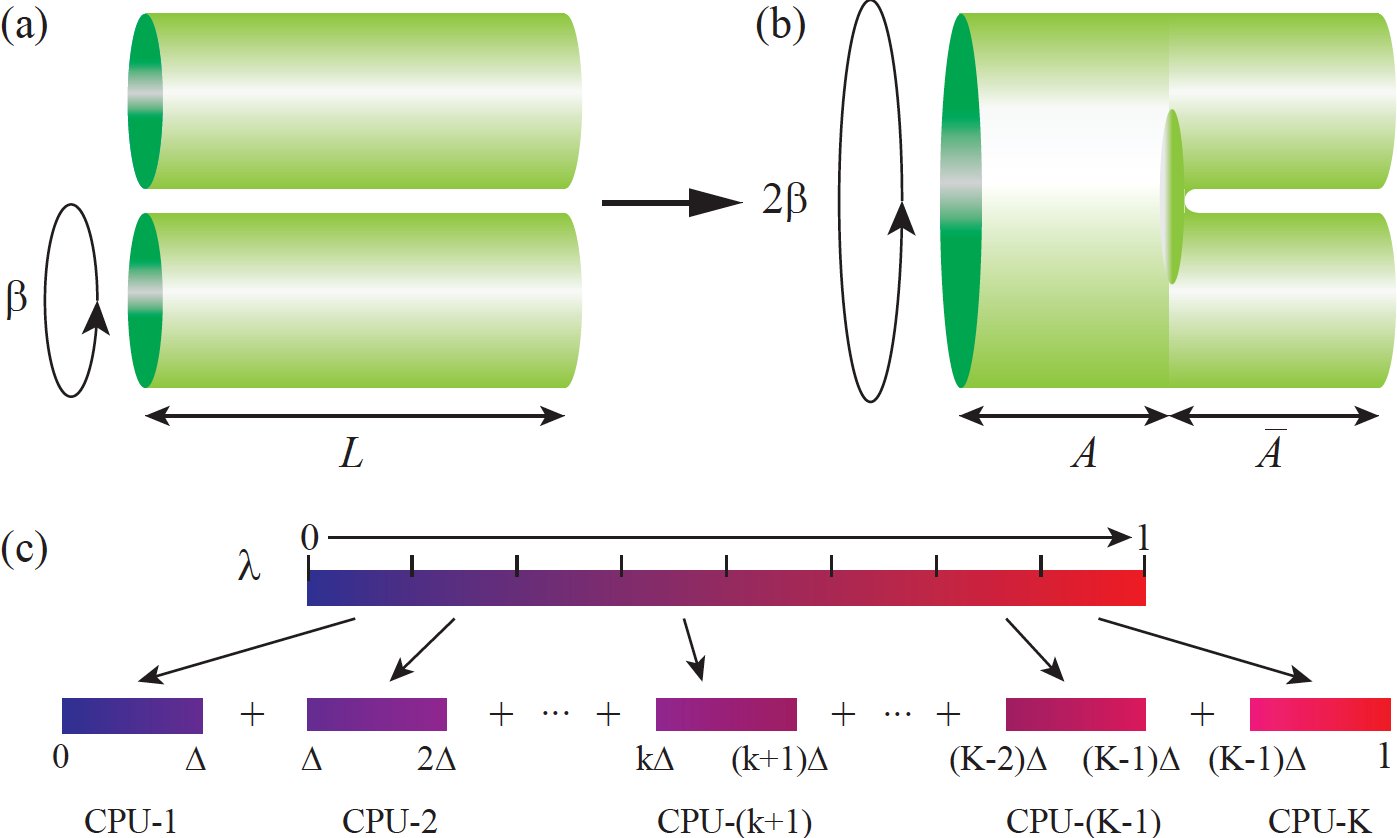
Quantum entanglement is the fundamental organizing principle of quantum matter. In particular, it is well-known that the scaling behavior of entanglement entropy (EE) provides deep insights into the structure of quantum states and gives universal invariants that can characterize phases and phase transitions. However, in 2D realistic models, the computation of EE is difficult due to the lack of a stable estimator, especially for the challenging lattice models with long-range interactions. Mr. Jiarui Zhao, Dr. Zheng Yan and Dr. Zi Yang Meng with their collaborators, developed a new nonequilibrium increment method, dubbed the "Qiu Ku" algorithm [see the Footnote] that makes use of the divide-and-conquer procedure of the nonequilibrium process to improve the speed of the simulation and the data quality of the entanglement measurement. They demonstrate the strength and versatility of the method with several challenging yet representative examples of 2D quantum many-body lattice models, in which the EEs are notoriously hard to obtain. At a conformally invariant 2D O(3) transition, the obtained EE exhibits universal scaling behavior of area law with logarithmic corner corrections. Furthermore, their results unambiguously reveal fundamental differences between the 2D deconfined quantum critical point and conventional quantum critical points. This work was published on Phys. Rev. Lett. 128, 010601 (2022).
Footnote: Qiu Ku is a Chinese word, where Qiu means autumn and Ku stands for a pair of pants. Literally Qiu Ku is a pair of trousers one wears when autumn arrives. In Chinese, Qiu Ku is more than a simple piece of clothing and expresses a nostalgia and sentiment in an affectionate way. In the present context, Qiu Ku is topologically equivalent to a pair of pants and it captures the manifold on which the partition function of the computation of 2nd Renyi EE is constructed. -
Discovery of intrinsic high-temperature ferromagnetism in 2D vanadium diselenide
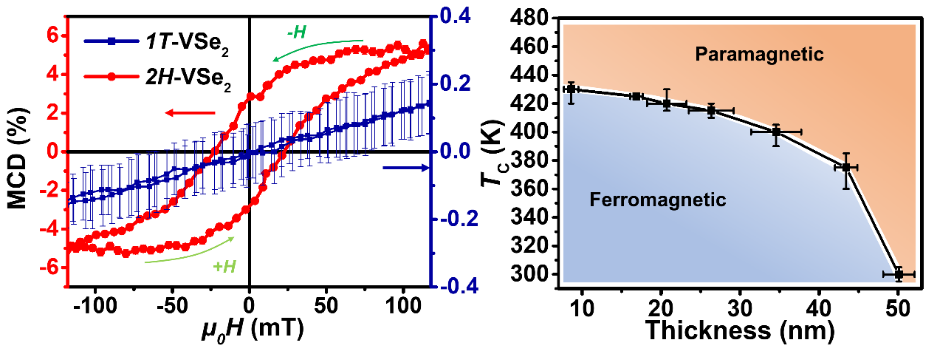
Caption: Comparison of representative MCD signals in multilayer 1T- and 2H-VSe2 at room temperature and the phase diagram of thickness-dependent Curie temperature depicts paramagnetic-ferromagnetic transition in 2H-VSe2 (adopted from ACS Nano 15, 16236 (2021)).
2D van der Waals ferromagnets carry a potential for ultimately miniature spintronics and information storage devices. Among the identified 2D ferromagnets, all inherit the magnetic ordering from their bulk ancestors. Recently, HKU physicists and co-workers demonstrated the multilayer 2H-phase VSe2, a member of the transition metal dichalcogenides, as a 2D ferromagnetic semiconductor with Curie temperature high above room temperature. The ferromagnetic ordering at room temperature exists only at 2D form with the thickness thinner than 50 nm owing to the enhanced structural anisotropy. This unique 2D ferromagnetic semiconductor manifests an enhanced magnetic ordering owing to the enhanced structural anisotropy at 2D limit. The experiment results evidence the 2D 2H-phase vanadium diselenide a promising candidate for the long-sought semiconductor based spintronics. This work is published in ACS Nano 15, 16236 (2021). -
Reconstruction and flat bands in twisted WSe2
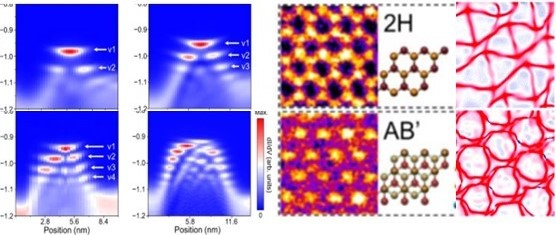
We uncovered the interface reconstruction of twisted WSe2, which exhibits a strong dependence on the constituent layer number and twist angles. The competition between the interlayer interaction leads to rich superlattice motifs and strain modulation. The number of ultra-ïŹat bands and spatial distribution of the wavefunctions match well with the theoretical predictions, providing a foundation for further study of correlated electronic phases. This work was published on Nat. Commun. 12, 5601 (2021). -
Fractionalized conductivity at 2D topological phase transitions
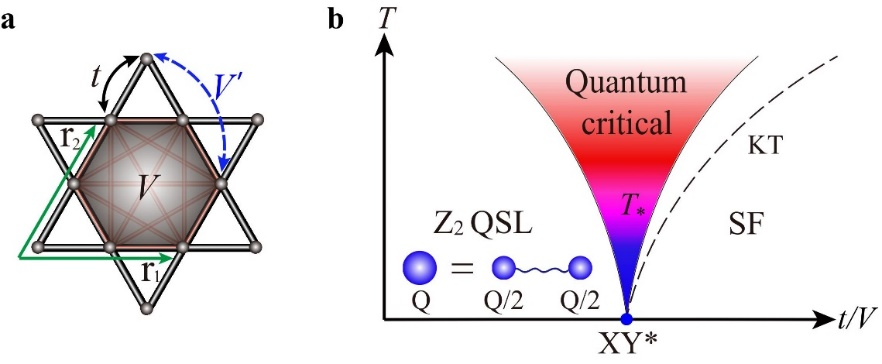
The experimental discovery of the fractional Hall conductivity in two-dimensional electron gases revealed new types of quantum particles, called anyons, which are beyond bosons and fermions as they possess fractionalized exchange statistics. These anyons are usually studied deep inside an insulating topological phase. It is natural to ask whether such fractionalization can be detected more broadly, say near a phase transition from a conventional to a topological phase. To answer this question, we (Dr. Zi Yang Meng and collaborators Dr. Yan-Cheng Wang from Xuzhou, China, Dr. Meng Cheng from Yale and Dr. William Witczak-Krempa from Montreal) study a strongly correlated quantum phase transition between a topological state, called a Z2 quantum spin liquid, and a conventional superfluid using large-scale quantum Monte Carlo simulations. Our results show that the universal conductivity at the quantum critical point becomes a simple fraction of its value at the conventional insulator-to-superfluid transition. Moreover, a dynamically self-dual optical conductivity emerges at low temperatures above the transition point, indicating the presence of the elusive vison particles. Our study opens the door for the experimental detection of anyons in a broader regime, and has ramifications in the study of quantum materials, programmable quantum simulators, and ultra-cold atomic gases. In the latter case, we discuss the feasibility of measurements in optical lattices using current techniques. The work was published on Nat. Commun. 12, 5347 (2021). -
Model design and computation solution for quantum moiré systems
Added note from author: The latter paper has received IOP Publishing Top Cited Paper Award in 2024, as one of the 1% most cited papers in IOP Publishing's portfolio from 2021-2023.
Two-dimensional quantum moiré materials represent artificial superlattice structures realized in a van der Waals stack of two or more 2D atomic crystals, including graphene, transition metal dichalcogenides, etc. The interplay between the quantum geometry of wavefunctions - as manifested in the distribution of Berry curvature, or fragile topology - and strong long-range Coulomb interactions, are the key ingredients for understanding the complex phase diagram of correlated states such as metal, insulator and superconductor in such materials. Z. Y. Meng and co-workers focus on model design and algorithmic developments to provide understanding of the correlation effect in such systems. They have performed quantum Monte Carlo simulations to reveal the phase diagram of twisted bilayer graphene (TBG) at charge neutrality (PRX 11, 011014(2021)) and developed the momentum space Monte Carlo method that can solve the long-range Coulomb interactions in an unbiased manner (CPL 38, 077305 (2021).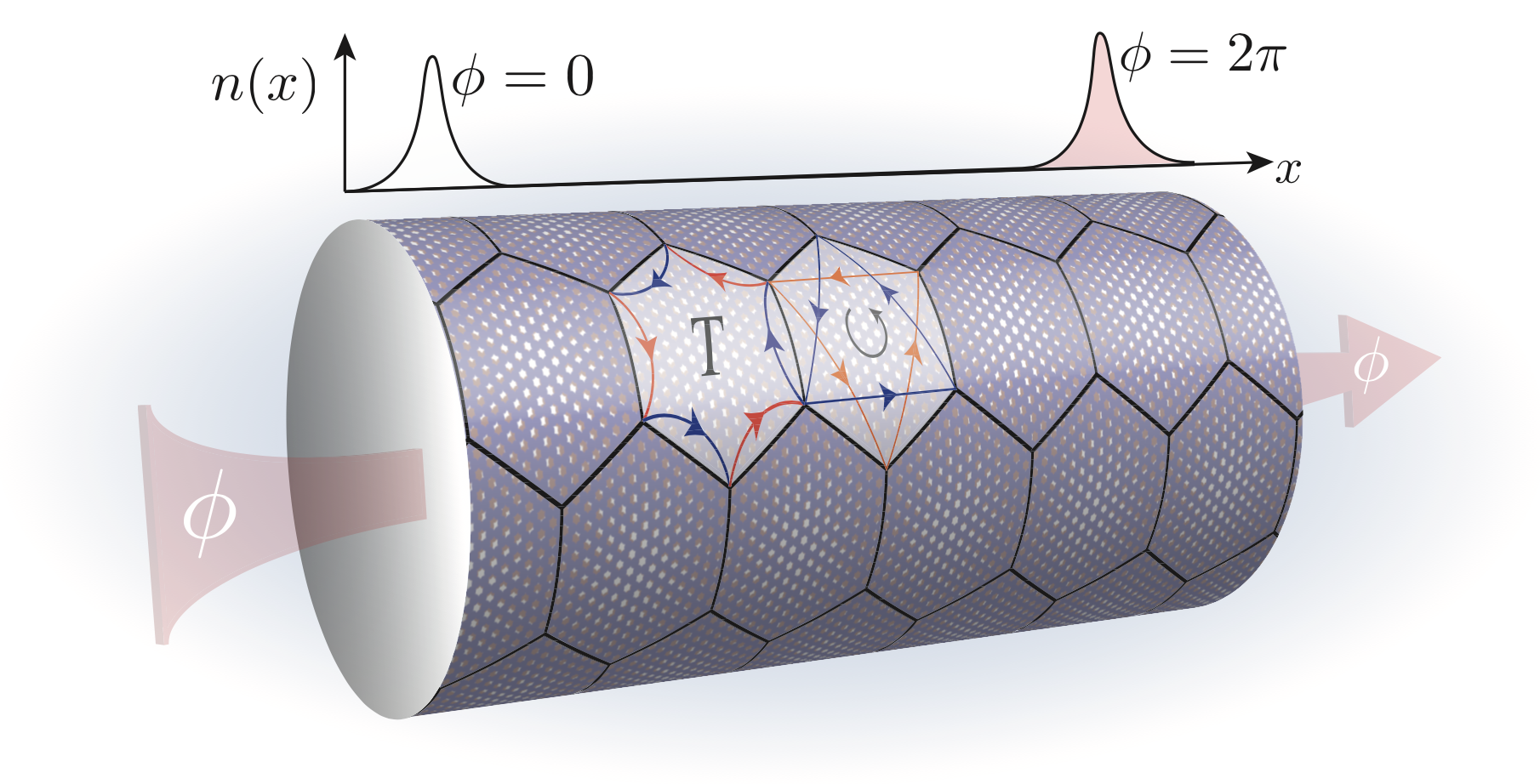
Computation of Hall conductance via flux insertion in the quantum anomalous Hall phase of the twisted bilayer graphene lattice model (adopted from Nat Comm 12, 5480 (2021)).
The experimental discovery of the fractional Hall conductivity in two-dimensional electron gases revealed new types of quantum particles, called anyons, which are beyond bosons and fermions as they possess fractionalized exchange statistics. These anyons are usually studied deep inside an insulating topological phase. It is natural to ask whether such fractionalization can be detected more broadly, say near a phase transition from a conventional to a topological phase. To answer this question, we (Dr. Zi Yang Meng and collaborators Dr. Yan-Cheng Wang from Xuzhou, China, Dr. Meng Cheng from Yale and Dr. William Witczak-Krempa from Montreal) study a strongly correlated quantum phase transition between a topological state, called a Z2 quantum spin liquid, and a conventional superfluid using large-scale quantum Monte Carlo simulations. Our results show that the universal conductivity at the quantum critical point becomes a simple fraction of its value at the conventional insulator-to-superfluid transition. Moreover, a dynamically self-dual optical conductivity emerges at low temperatures above the transition point, indicating the presence of the elusive vison particles. Our study opens the door for the experimental detection of anyons in a broader regime, and has ramifications in the study of quantum materials, programmable quantum simulators, and ultra-cold atomic gases. In the latter case, we discuss the feasibility of measurements in optical lattices using current techniques. The work was published on Nat. Commun. 12, 5347 (2021).
Recently, they employ the large-scale density matrix renormalization group computation on the lattice model for TBG at 3/4 filling containing the projected Coulomb interactions only, and succeeded in identifying a first-order quantum phase transition between the insulating stripe phase and the quantum anomalous Hall state with the Chern number of ± 1. These results not only shed light on the mechanism of the quantum anomalous Hall state discovered at three-quarters filling in the material, but also provide an example of the topological Mott insulator, i.e., the quantum anomalous Hall state in the strong coupling limit. This work is published in Nat Commun 12, 5480 (2021).
-
2024-25 HKU Science JSI Workshops - Exploring Wonders of Flatland in Physics
Talk by Dr Dong-Keun Ki
Date/Time: November 23, 2024 (Sat) 9:00pm-5:30pm
Delivery: On campus
When materials become extremely thin, over 100,000 times thinner than a human hair, new physics emerges as they exist only in two dimensions, in a "flatland". Remarkably, physicists have found that such thin materials can be realised simply using sticky tapes. In this workshop, we will explore the wonders of the flatland and provide hands-on demonstrations. -
2022-23 HKU Science JSI Workshops - Exploring Wonders of Flatland in Physics
Talk by Dr Dong-Keun Ki
Date/Time: November 12, 2022 (Sat) 9:00pm-4:30pm
Delivery: On campus
Photos: https://www.scifac.hku.hk/photo-gallery/2223firstsemphy
Have you ever wondered what would happen if materials become so thin and flat? Physicists have asked the same question for years and found various ways to explore such a "Flatland". Unlike how difficult it sounds, one can now get even only one-atom-thin layer using sticky tapes. We will talk about the wonders of such "flatlands" in physicists' viewpoint. -
2021-22 HKU Science JSI Workshops - Exploring Wonders of Flatland in Physics
Talk by Dr Dong-Keun Ki
Date/Time: October 23, 2021 (Sat) 1:30pm-3:15pm
Delivery: Zoom
Have you ever wondered what would happen if materials become so thin and flat? Physicists have asked the same question for years and found various ways to explore such a "Flatland". Unlike how difficult it sounds, one can now get even only one-atom-thin layer using sticky tapes. We will talk about the wonders of such "flatlands" in physicists' viewpoint.
-
The Hong Kong Forum of Physics 2024: Recent Progresses on 2D Quantum Materials
Date: 16 - 19 December, 2024 (Monday - Thursday)
Venue: CYPP3, LG1/F, Chong Yuet Ming Physics Building, Main Campus, HKU -
2D Transition Metal Dichalcogenides 2024
Date: 20 - 23 May, 2024 (Monday - Thursday)
Venue: he Hong Kong Polytechnic University, Hong Kong -
The Hong Kong Forum of Physics 2022: Frontiers of Quantum Materials Research
Date: 12 - 15 December, 2022 (Monday - Thursday)
Venue: (Hybrid Mode) Lecture Theatre 4-5, 1/F, Meng Wah Complex, Main Campus, HKU
-
Steady Floquet–Andreev states in graphene Josephson junctions
by Dr. Gil-Ho Lee, Department of Physics, Pohang University of Science and Technology
Date/Time: April 29, 2022 (Fri) 2:00 pm
Delivery: Zoom -
Model design and Computational solutions for quantum moiré systems
by Dr. Zi Yang Meng, Department of Physics, The University of Hong Kong
Date/Time: October 15, 2021 (Fri) 3:00 pm
Delivery: Zoom
-
âCrossed nonlinear dynamical Hall effect in twisted bilayers”, C Chen, D Zhai, C Xiao, W Yao, Phys. Rev. Res., 6 (2024).
-
âTuning the atomic and electronic structures of mirror twin boundaries in molecular beam epitaxy grown MoSe₂ monolayers via rhenium doping”, Z B Yu, Y P Xia, H P Komsa, J Q Zhang, M H Xie, C H Jin, 2D Mater., 11, 025010 (2024).
-
âQuantum criticality and entanglement for the two-dimensional long-range Heisenberg bilayer”, M H Song, J R Zhao, Y Qi, J C Rong, and Z Y Meng, Phys. Rev. B 109, L081114 (2024).
-
âUbiquitous nematic Dirac semimetal emerging from interacting quadratic band touching systems”, H Y Lu, K Sun, Z Y Meng, and B B Chen, Phys. Rev. B 109, L081106 (2024).
-
âInterfacial magnetic spin Hall effect in van der Waals Fe₃GeTe₂MoTe₂ heterostructure.”, Y D Dai, J L Xiong, Y F Ge, B Cheng, L Z Wang, P F Wang, Z L Liu, S N Yan, C W Zhang, X H Xu, Y G Shi, S W Cheong, C Xiao, S A Yang, S J Liang, F Miao, Nat. Commun., 15, 1, 10. 1129 (2024).
-
âGinzburg-Landau Theory of Flat-Band Superconductors with Quantum Metric”, S A Chen and K T Law, Phys. Rev. Lett. 132, 026002 (2024).
-
âCompensating losses in polariton propagation with synthesized complex frequency excitation.”, F X Guan, X D Guo, S Zhang, K B Zeng, Y Hu, C C Wu, S B Zhou, Y J Xiang, X X Yang, Q Dai, S Zhang, Nat. Mater., Early Access (2024).
-
âDeciphering the ultra-high plasticity in metal monochalcogenides.”, L W Wong, K Yang, W Han, X D Zheng, H Y Wong, C S Tsang, C S Lee, S P Lau, T H Ly, M Yang, J Zhao, Nat. Mater., Early Access (2024).
-
âSynthesized complex-frequency excitation for ultrasensitive molecular sensing.”, K Zeng, C Wu, X Guo, F Guan, Y Duan, LL Zhang, X Yang, N Liu, Q Dai, S Zhang, eLight 4, 1 (2024).
-
âNonlinear transport and radio frequency rectification in BiTeBr at room temperature.”, X F Lu, C P Zhang, N Z Wang, D Zhao, X Zhou, W B Gao, X H Chen, K T Law, K P Loh, Nat. Commun., 15, 245 (2024).
-
âDynamically tunable moiré exciton Rydberg states in a monolayer semiconductor on twisted bilayer graphene.”, M H He, J Q Cai, H Y Zheng, E Seewald, T Taniguchi, K Watanabe, J Q Yan, M Yankowitz, A Pasupathy, W Yao, X D Xu, Nat. Mater., Early Access(2024).
-
âLandau-Level Spectrum and the Effect of Spin-Orbit Coupling in Monolayer Graphene on Transition Metal Dichalcogenides.”, Q Rao, H X Xue, D K Ki, Phys. Status Solidi B-2300397 (2024).
-
âScratching lithography, manipulation, and soldering of 2D materials using microneedle probes.”, Q Rao, G Y Gao, X Y Wang, H X Xue, D K Ki, AIP Adv., 14, 1, 7. 015333 (2024).
-
âCross-dimensional valley excitons from Forster coupling in arbitrarily twisted stacks of monolayer semiconductors.”, C Li, W Yao, 2D Mater., 11, 015006 (2024).
-
âExtendable piezo/ferroelectricity in nonstoichiometric 2D transition metal dichalcogenides.”, Y Hu, L Rogée, W Z Wang, L Zhuang, F Y Shi, H Dong, S H Cai, B K Tay, S P Lau, Nat. Commun., 14, 8470 (2023).
-
âTransient measurement of near-field thermal radiation between macroscopic objects.”, S Zhang, Y D Dang, X R Li, Y X Li, Y Jin, P K Choudhury, J B Xu, Y G Ma, Nanoscale, 16, 1167-1175 (2024).
-
âCorrelating Young's Modulus with High Thermal Conductivity in Organic Conjugated Small Molecules.”, J H Zeng, T Liang, J J Zhang, D Q Liu, S Li, X H Lu, M Han, Y M Yao, J B Xu, R Sun, L J Li, Small, 11. (2023).
-
âPhase-Controlled Growth of 1T'-MoS₂ Nanoribbons on 1H-MoS₂ Nanosheets.”, Y J Wang, W Zhai, Y Ren, Q H Zhang, Y Yao, S Y Li, Q Yang, X C Zhou, Z J Li, B L Chi, J Z Liang, Z He, L Gu, H Zhang, Adv. Mater., 230726 (2023).
-
âQuantitative analysis of polarization behaviors of trion states in monolayer WS₂ in a magnetic field.”, Z J Jin, B K Li, G H Cheng, C J Zhou, H Li, and J N Wang, Phys. Rev. Applied. 20.064023 (2023).
-
âConcept for a fractional energy barrier tunneling junction.”, Y C Chen, D K Ki, Z B Li, J Chen, Appl. Phys. Lett., 123, 243503 (2023).
-
âEpitaxial Growth of 1D Te/2D MoSe₂ Mixed-Dimensional Heterostructures for High-Efficient Self-Powered Photodetector.”, J W You, Z J Jin, Y Y Li, T Kang, K A Zhang, W L Wang, M Y Xu, Z L Gao, J N Wang, J K Kim, Z T Luo, Adv. Funct. Mater., 202311134 (2023).
-
âRadiative thermal coats for passive temperature management.”, Y D Dang, Y Zhou, Y X Li, S Zhang, X R Li, Y Jin, P K Choudhury, J B Xu, Y G Ma, Appl. Phys. Lett., 123, 222201 (2023).
-
âAxion insulator state in hundred-nanometer-thick magnetic topological insulator sandwich heterostructures.”, D Y Zhuo, Z J Yan, Z T Sun, L J Zhou, Y F Zhao, R X Zhang, R B Mei, H Yi, K Wang, M H W Chan, C X Liu, K T Law, C Z Chang, Nat. Commun., 14, 7596 (2023).
-
âA Mechanisms of temperature-dependent thermal transport in amorphous silica from machine-learning molecular dynamics.”, T Liang, P H Ying, K Xu, Z Q Ye, C Ling, Z Y Fan, J B Xu, Phys. Rev. B, 108, 184203 (2023).
-
âArbitrary Wireless Energy Distribution within an Epsilon Near-zero Environment.”, Q D Yang, Y Wang, J H Shi, C X Liu, S Zhang, Laser Photon. Rev., 202300631 (2023).
-
âTunable Kerker Scattering in a Self-Coupled Polaritonic Metasurface.”, F H Shen, Y Q Zhou, J W Ma, J P Zheng, J F Wang, Z F Chen, J B Xu, Laser Photon. Rev., 202300584 (2023).
-
âBulk-local-density-of-state correspondence in topological insulators.”, B Y Xie, R W Huang, S Y Jia, Z M Lin, J Z Hu, Y Jiang, S J Ma, P Zhan, M H Lu, Z L Wang, Y F Chen, S Zhang, Nat. Commun., 14, 7347 (2023).
-
âConcentric gradient nanoplasmonic sensors for detecting tumor-derived extracellular vesicles.”, H T Feng, S Y Min, Y Q Huang, Z F Gan, C W Liang, W D Li, Y Chen, Sens. Actuator B-Chem., 400, 134899 (2024).
-
âCaution on Gross-Neveu criticality with a single Dirac cone: Violation of locality and its consequence of unexpected finite-temperature transition.”, Y D Liao, X Y Xu, Z Y Meng, Y Qi, Phys. Rev. B, 108, 195112 (2023).
-
âRoom-temperature-processed transparent hemispherical optoelectronic array for electronic eyes.”, Z Gao, L Mei, J K Zhou, Y Fu, L Zhai, Z Y Li, R J Yang, D F Li, Q Zhang, J H He, J Li, X C Huang, H Li, Y M Liu, K M Yao, Y Y Gao, L Zheng, Y Chen, D Y Lei, H Zhang, Z Y Zeng, X E Yu, Mater. Today, 69, 31-40. (2023).
-
âMetallic Micro-Nano Network-Based Soft Transparent Electrodes: Materials, Processes, and Applications.”, L Y Chen, A Khan, S Q Dai, A Bermak, W D Li, Adv. Sci., 10, 2302858 (2023).
-
âIntrinsic Nonlinear Hall Effect and Gate-Switchable Berry Curvature Sliding in Twisted Bilayer Graphene.”, M Z Huang, Z F Wu, X Zhang, X M Feng, Z S Zhou, S Wang, Y Chen, C Cheng, K Sun, Z Y Meng, and N Wang, Phys. Rev. Lett., 131, 066301 (2023).
-
âCurrent induced second-order nonlinear Hall effect in bulk WTe₃.”, H Li, M X Li, R C Xiao, W H Liu, L Wu, W Gan, H Han, X Tang, C J Zhang, J N Wang, Appl. Phys. Lett., 123, 163102 (2023).
-
âSynergistic effect of chiral metasurface and hot carrier injection enabling manipulation of valley polarization of WSe2 at room temperature”, Z. F. Chen, F. H. Shen, Z. H. Zhang, K. Wu, Y. X. Jin, M. Z. Long, S. J. Wang, J. B. Xu, Adv. Phys Res. 3, 2300062 (2023).
-
âFinite-temperature critical behaviors in 2D long-range quantum Heisenberg model”, J R Zhao, M H song, Y Qi, J C Rong, and Z Y Meng, npj Quantum Materials 8, 59 (2023).
-
âDistinct moir&eacuté textures of in-plane electric polarizations for distinguishing moiré origins in homobilayers”, H Y Yu, Z H Zhou, W Yao, Sci. China-Phys. Mech. Astron., 66, 107711 (2023).
-
âBallistic transport spectroscopy of spin-orbit-coupled bands in monolayer graphene on WSe₃.”, Q Rao, W H Kang, H X Xue, Z Q Ye, X M Feng, K Watanabe, T Taniguchi, N Wang, M H Liu, D K Ki, Nat. Commun., 14, 6124 (2023).
-
âQuantum Monte Carlo calculation of critical exponents of the Gross-Neveu-Yukawa on a two-dimensional fermion lattice model.”, T T Wang, Z Y Meng, Phys. Rev. B, 108, L121112 (2023).
-
âMajorana fermions on the domain wall of marginally twisted bilayer of transition metal dichalcogenides.”, R C Huang, D P Yu, W Yao, Phys. Rev. B, 108, 115307 (2023).
-
âTwist-Dependent Anisotropic Thermal Conductivity in Homogeneous MoS₂ Stacks.”, W W Jiang, T Liang, J B Xu, W E Ouyang, Int. J. Heat Mass Transf., 217, 124662 (2023).
-
âQuantum optimization within lattice gauge theory model on a quantum simulator.”, Z Yan, Z Zhou, Y H Zhou, Y C Wang, X Z Qiu, Z Y Meng, X F Zhang, npj Quantum Inform., 9, 89 (2023).
-
âPhase-dependent growth of Pt on MoS₂ for highly efficient HMoS₂ evolution.”, Z Y Shi, X Zhang, X Q Lin, G G Liu, C Y Ling, S B Xi, B Chen, Y Y Ge, C L Tan, Z C Lai, Z Q Huang, X Y Ruan, L Zhai, L J Li, Z J Li, X X Wang, G H Nam, J W Liu, Q Y He, Z Q Guan, J L Wang, C S Lee, A R J Kucernak, H Zhang, Nature, 621, 300-305 (2023).
-
â2D Dual Gate Field-Effect Transistor Enabled Versatile Functions.”, Y Pang, Y Q Zhou, L Tong, J B Xu, Small, 20, 2304173 (2023).
-
âClassical fully packed loop model with attractive interactions on the square lattice.”, B Dabholkar, X X Ran, J C Rong, Z Yan, G J Sreejith, Z Y Meng, F Alet, Phys. Rev. B, 108, 125112 (2023).
-
âMany versus one: The disorder operator and entanglement entropy in fermionic quantum matter.”, W L Jiang, B B Chen, Z H Liu, J C Rong, F F Assaad, M Cheng, K Sun, Z Y Meng, SciPost Phys., 15, 082 (2023).
-
âStable computation of entanglement entropy for two-dimensional interacting fermion systems”, G P Pan, Y D Liao, W L Jiang, J D'Emidio, Y Qi, and Z Y Meng, Phys. Rev. B 108, L081123 (2023).
-
âRadiative Thermal Transistor.”, Y Li, Y D Dang, S Zhang, X R Li, Y Jin, P Ben-Abdallah, J B Xu, Y G Ma, Phys. Rev. Appl., 20, 024061 (2023).
-
âChiral Ligand-Induced Inversion and Tuning of Excitonic Optical Activity in Intrinsically Chiral CsPbBr₃ Perovskite Nanoplatelets.”, B Tang, S Wang, H Liu, N Mou, A S Portniagin, P Chen, Y Wu, X Gao, D Lei, A L Rogach, Adv. Opt. Mater., 12, 4, 2301524. (2024).
-
âObservation of fractionally quantized anomalous Hall effect.”, H Park, J Q Cai, E Anderson, Y N Zhang, J Y Zhu, X Y Liu, C Wang, W Holtzmann, C W Hu, Z Y Liu, T Taniguchi, K Watanabe, J H Chu, T Cao, L Fu, W Yao, C Z Chang, D Cobden, D Xiao, X D Xu, Nature, 622, 74-79 (2023).
-
âRemote gate control of topological transitions in moire superlattices via cavity vacuum fields.”, Z H Lin, C X Xiao, D P Nguyen, G Arwas, C Ciuti, W Yao, Proc. Natl. Acad. Sci. U. S. A., 120, e2306584120 (2023).
-
âDifferent temperature dependence for the edge and bulk of the entanglement Hamiltonian.”, M H Song, J R Zhao, Z Yan, and Z Y Meng, Phys. Rev. B 108, 075114 (2023).
-
âUltrahigh supercurrent density in a two-dimensional topological material.”, Q Zhang, M S Hossain, B Casas, W K Zheng, Z J Cheng, Z C Lai, Y H Tu, G Q Chang, Y Yao, S Y Li, Y X Jiang, S Mardanya, T R Chang, J Y You, Y P Feng, G M Cheng, J X Yin, N Shumiya, T A Cochran, X P Yang, M Litskevich, N Yao, K Watanabe, T Taniguchi, H Zhang, L Balicas, M Z Hasan, Phys. Rev. Mater., 7, L071801 (2023).
-
âDynamical properties of quantum many-body systems with long-range interactions.”, M H Song, J R Zhao, C K Zhou, Z Y Meng, Phys. Rev. Res., 5, 033046 (2023).
-
âSub-Micrometer Phonon Mean Free Paths in Metal-Organic Frameworks Revealed by Machine Learning Molecular Dynamics Simulations.”, P H Ying, T Liang, K Xu, J Zhang, J B Xu, Z Zhong, Z Y Fan, ACS Appl. Mater. Interfaces, 15, 30, 36412-36422. (2023).
-
âIn-Plane Electric-Field-Induced Orbital Hybridization of Excitonic States in Monolayer WSe₂.”, B R Zhu, K Xiao, S Y Yang, K Watanabe, T Taniguchi, X D Cui, Phys. Rev. Lett., 131, 036901 (2023).
-
âContact-engineered reconfigurable two-dimensional Schottky junction field-effect transistor with low leakage currents.”, Y Q Zhou, L Tong, Z F Chen, L Tao, Y Pang, J B Xu, Nat. Commun., 14, 4270 (2023).
-
âProgramming correlated magnetic states with gate-controlled moiré geometry.”, E Anderson, F-R Fan, J Cai, W Holtzmann, T Taniguchi, K Watanabe, D Xiao, W Yao, X Xu, Science, 381, 6655, 325-330. (2023).
-
âSignatures of fractional quantum anomalous Hall states in twisted MoTe₂”, J Cai, E Anderson, C Wang, X Zhang, X Liu, W Holtzmann, Y Zhang, F Fan, T Taniguchi, K Watanabe, Y Ran, T Cao, L Fu, D Xiao, W Yao, X Xu, Nature 622, 63-68 (2023).
-
âOrbital Fulde-Ferrell Pairing State in Moire Ising Superconductors”, Y M Xie, K T Law, Phys. Rev. Lett., 131, 016001 (2023).
-
âNiobium and rhenium doping in MoSe₂ monolayer during molecular beam epitaxy: Shallow dopants and defect proliferation”, Y J Q Zhang, Y P Xia, Z B Yu, X Y Yue, Y J Jin, M F Yuan, Y Feng, B Li, B Wang, W K Ho, C Liu, H Xu, C H Jin, M H Xie, APL Mater., 11, 071113 (2023).
-
âFormation mechanism of mirror twin grain boundaries in molecular beam epitaxy grown monolayer WSe₂-MoSe₂ lateral heterojunctions”, Z B Yu, Y W Dai, H P Komsa, X B Ren, M F Yuan, M H Xie, C H Jin, 2D Mater., 10, 035010 (2023).
-
âJosephson Diode Effect Induced by Valley Polarization in Twisted Bilayer Graphene”, J X Hu, Z T Sun, Y M Xie, and K T Law, Phys. Rev. Lett., 130, 266003 (2023).
-
âFermion Disorder Operator at Gross-Neveu and Deconfined Quantum Criticalities.”, Z H Liu, W L Jiang, B B Chen, J C Rong, M Cheng, K Sun, Z Y Meng, F F Assaad, Phys. Rev. Lett., 130, 266501 (2023).
-
âPolynomial sign problem and topological Mott insulator in twisted bilayer graphene”, X Zhang, G P Pan, B B Chen, H Q Li, K Sun, Z Y Meng, Phys. Rev. B, 107, L241105 (2023).
-
âGauge Field Induced Chiral Zero Mode in Five-Dimensional Yang Monopole Metamaterials.”, S J Ma, H W Jia, Y G Bi, S Q Ning, F X Guan, H C Liu, C J Wang, S Zhang, Phys. Rev. Lett., 130, 243801 (2023).
-
âKramers nodal lines and Weyl fermions in SmAlSi”, Y C Zhang, Y X Gao, X J Gao, S M Lei, Z L Ni, J S Oh, J W Huang, Z Q Yue, M Zonno, S Gorovikov, M Hashimoto, D H Lu, J D Denlinger, R J Birgeneau, J Kono, L Wu, K T Law, E Morosan, M Yi, Commun. Phys., 6, 134 (2023).
-
âReversible semimetal-semiconductor transition of unconventional-phase WS₂ nanosheets.”, W Zhai, J L Qi, C Xu, B Chen, Z J Li, Y J Wang, L Zhai, Y Yao, S Y Li, Q H Zhang, Y Y Ge, B L Chi, Y Ren, Z Q Huang, Z C Lai, L Gu, Y Zhu, Q Y He, and H Zhang, J. Am. Chem. Soc. 145, 13444-13451 (2023).
-
âBlack Phosphorus/Ferroelectric P(VDF-TrFE) Field-Effect Transistors with High Mobility for Energy-Efficient Artificial Synapse in High-Accuracy Neuromorphic Computing.”, Nano Lett., 14, 6752-6759 (2023), Nano Lett., 14, 6752-6759 (2023).
-
âDipole ladders with large Hubbard interaction in a moire exciton lattice.”, H Park, J Y Zhu, X Wang, Y Q Wang, W Holtzmann, T Taniguchi, K Watanabe, J Q Yan, L Fu, T Cao, D Xiao, D R Gamelin, H Y Yu, W Yao, X D Xu, Nat. Phys., 19, 1286-1292 (2023).
-
âMemristors based on 2D MoSe₂ nanosheets as artificial synapses and nociceptors for neuromorphic computing”, H Duan, D H Wang, J X Gou, F Guo, W J Jie, J H Hao, Nanoscale, 15, 23, 10089-10096. (2023).
-
âEmergent Glassy Behavior in a Kagome Rydberg Atom Array.”, Z Yan, Y C Wang, R Samajdar, S Sachdev, Z Y Meng, Phys. Rev. Lett., 130, 206501 (2023).
-
âThird-order charge transport in a magnetic topological semimetal.”, Z M Zhu, H Y Liu, Y H Ge, Z Y Zhang, W K Wu, C Xiao, S A Yang, Phys. Rev. B, 107, 205120 (2023).
-
âMid-infrared analogue polaritonic reversed Cherenkov radiation in natural anisotropic crystals.”, X D Guo, C C Wu, S Zhang, D B Hu, S P Zhang, Q Jiang, X K Dai, Y Duan, X X Yang, Z P Sun, S Zhang, H X Xu, Q Dai, Nat. Commun., 14, 2532 (2023).
-
âSubstrate Effect on Band Bending of MoSe₂ Monolayer Near Mirror-Twin Domain Boundaries.”, M F Yuan, J Q Zhang, X Y Yue, Y P Xia, Y J Jin, W K Ho, M H Xie*, Adv. Electron. Mater., 9, 2300112 (2023).
-
âSingle Photon Emitters with Polarization and Orbital Angular Momentum Locking in Monolayer Semiconductors.”, D Zhang, D W Zhai, S Deng, W Yao, Q Z Zhu, Nano Lett., 23, 9, 3851-3857. (2023).
-
âUnlocking the general relationship between energy and entanglement spectra via the wormhole effect.”, Z Yan, Z Y Meng, Nat. Commun., 14, 2360 (2023).
-
âTime-Reversal-Even Nonlinear Current Induced Spin Polarization.”, C Xiao, W K Wu, H Wang, Y X Huang, X L Feng, H Y Liu, G Y Guo, Q Niu, S A Yang, Phys. Rev. Lett., 130, 166302 (2023).
-
âf0-Josephson junction in twisted bilayer graphene induced by a valley-polarized state”, Y M Xie, D K Efetov, K T Law, Phys. Rev. Res., 5, 023029 (2023).
-
âTime-reversal even charge hall effect from twisted interface coupling”, D W Zhai, C Chen, C Xiao, W Yao, Nat. Commun., 14, 1961 (2023).
-
âMethoxy Functionalization of Phenethylammonium Ligand for Efficient Perovskite Light-Emitting Diodes.”, X W Sun, T Liang, K H Ngai, Z G Nie, K Z Fan, S Li, C C S Chan, K S Wong, X H Lu, J B Xu, M Z Long, Adv. Opt. Mater., 11, 2300464 (2023).
-
âElectronic/Optoelectronic Memory Device Enabled by Tellurium-based 2D van der Waals Heterostructure for in-Sensor Reservoir Computing at the Optical Communication Band.”, J J Zha, S H Shi, A Chaturvedi, H X Huang, P Yang, Y Yao, S Y Li, Y P Xia, Z M Zhang, W Wang, H D Wang, S C Wang, Z Yuan, Z B Yang, Q Y He, H L Tai, E H T Teo, H Y Yu, J C Ho, Z R Wang, H Zhang, C L Tan, Adv. Mater., 35, 2211598 (2023).
-
âIntrinsic Nonlinear Planar Hall Effect.”, Y X Huang, X L Feng, H Wang, C Xiao, S A Yang, Phys. Rev. Lett., 130, 126303 (2023).
-
âEvery-other-layer dipolar excitons in a spin-valley locked superlattice.”, Y N Zhang, C X Xiao, D Ovchinnikov, J Y Zhu, X Wang, T Taniguchi, K Watanabe, J Q Yan, W Yao, X D Xu, Nat. Nanotechnol., 18, 501-506 (2023).
-
âFully packed quantum loop model on the square lattice: Phase diagram and application for Rydberg atoms.”, X X Ran, Z Yan, Y C Wang, J C Rong, Y Qi, Z Y Meng, Phys. Rev. B, 107, 125134 (2023).
-
âVariable thermal transport in black, blue, and violet phosphorene from extensive atomistic simulations with a neuroevolution potential.”, P H Ying, T Liang, K Xu, J B Xu, Z Y Fan, T Ala-Nissila, Z Zhong, Int. J. Heat Mass Transf., 202, 123681 (2023).
-
âTransmission-Matrix Quantitative Phase Profilometry for Accurate and Fast Thickness Mapping of 2D Materials”, Y J Nie, N S Zhou, L Tao, J L Zhu, Z L Gao, J B Xu, and R J Zhou, ACS Photonics 10, 1084-1092 (2023).
-
âBerry curvature, spin Hall effect, and nonlinear optical response in moire transition metal dichalcogenide heterobilayers”, J X Hu, Y M Xie, and K. T. Law, Phys. Rev. B 107, 075424 (2023).
-
âDynamic Generation of Spin Spirals of Moire Trapped Carriers via Exciton Mediated Spin Interactions”, C X Xiao, Y Wang, and W Yao, Nano Lett. 23, 1872-1877 (2023).
-
âIntercell moiré exciton complexes in electron lattices” , X Wang, X Zhang, J Zhu, H Park, Y Wang, C Wang, W Holtzmann, T Taniguchi, K Watanabe, J Yan, D Gamelin, W Yao, D Xiao, T Cao, X Xu, Nature Materials (2023).
-
âWafer-scale single-crystalline MoSe₂ and WSe₂ monolayers grown by molecular-beam epitaxy at low-temperature — the role of island-substrate interaction and surface steps” , Y Xia, D Ding, K Xiao, J Zhang, S Xu, D He, X Yue, Q Rao, X Wang, S Ding, G Gao, H Xue, Y Wang, M Yuan, W Ho, D Ki, Hu Xu, X Cui, C Jin, M Xie, Natural Sciences, 20220059 (2023).
-
âVertical Nonvolatile Schottky-Barrier-Field-Effect Transistor with Self-Gating Semimetal Contact” , Y Zhou, L. Tong, Z Chen, L Tao, H Li, Y Pang, J Xu, Adv. Fun. Mater., 33, 2213254 (2023).
-
âHigh-fidelity and clean nanotransfer lithography using structure-embedded and electrostatic-adhesive carriers” , Z Gan, J Cai, Z Sun, L Chen, C Sun, J Yu, Z Liang, S Min, F Han, T Liu, X Cheng, S Yu, D Cui, W Li, Microsyst. Nanoeng, 9, 8 (2023).
-
âUnconventional ferroelectricity in half-filling states of antiparallel stacking of twisted WSe₂” , L An, Z Zhou, X Feng, M Huang, X Cai, Y Chen, P Zhao, X Dai, J Zhang, W Yao, J Liu, N Wang, National Science Open, 2, 20220033 (2023).
-
âThermodynamic Characteristic for a Correlated Flat-Band System with a Quantum Anomalous Hall Ground State” , G Pan, H Lu, H Li, X Zhang, B Chen, K Sun, Z Meng, Phys. Rev. Lett.,130, 016401 (2023).
-
âQuantum Solid Phase and Coulomb Drag in 2D Electron – Electron Bilayers of MoS₂” , M Huang, Z Wu, N Wang, S Chui, Adv. Electron. Mater., 2201105 (2023).
-
âSpin-orbit-parity coupled superconductivity in atomically thin 2M-WS₂” , E Zhang, Y Xie, Y Fang, J Zhang, X Xu, Y Zou, P Leng, X Gao, Y Zhang, L Ai, Y Zhang, Z Jia, S Liu, J Yan, W Zhao, S Haigh, X Kou, J Yang, F Huang, K Law, F Xiu, S Dong, Nat. Phys., 19, 106-+ (2023).
-
âDetecting subsystem symmetry protected topological order through strange correlators” , C Zhou, M Li, Z Yan, P Ye, Z Meng, Phys. Rev. B., 106, 214428 (2022).
-
âProgress in the synthesis of 2D black phosphorus beyond exfoliation” , Y Zhao, Z Wu, Z Dang, J Hao, Appl. Phys. Rev., 9, 041318 (2022).
-
âScaling of the Disorder Operator at Deconned Quantum Criticality” , Y Wang, N Ma, M Cheng, Z Meng, SciPost Physics, 13, 123 (2022).
-
âTwo-Dimensional Nanomaterial-Templated Composites” , Z Shi, Y Ge, Q Yun, H Zhang, Acc. Chem. Res., 55, 3581-3593 (2022).
-
âSynthesis and enhanced piezoelectric response of CVD-grown SnSe layered nanosheets for flexible nanogenerators” , F Yang, M Wong, J Mao, Z Wu, J Hao, Nano Res (2022).
-
âHot exciton effect in photoluminescence of monolayer transition metal dichalcogenide” , K Xiao, R Duan, Z Liu, K Watanabe, T Taniguchi, W Yao, X Cui, Natural Sciences, 3, e20220035 (2023).
-
âSuperconductivity and bosonic fluid emerging from moire flat bands” , X Zhang, K Sun, H Li, G Pan, Z Meng, Phys. Rev. B., 106, 184517 (2022).
-
âA sport and a pastime: Model design and computation in quantum many-body systems” , G Pan, W Jiang, Z Meng, Chinese Physics B., 31, 127101 (2022).
-
âExperimental Identification of the Second-Order Non-Hermitian Skin Effect with Physics-Graph-Informed Machine Learning” , C Shang, S Liu, R Shao, P Han, X Zang, X Zhang, K Salama, W Gao, C Lee, R Thomale, A Manchon, S Zhang, T Cui, U Schwingenschlogl, Adv. Sci., 9 (2022).
-
âIn situ Observation of Structural Evolution and Phase Engineering of Amorphous Materials during Crystal Nucleation” , X Han, G Wu, Y Ge, S Yang, D Rao, Z Guo, Y Zhang, M Yan, H Zhang, L Gu, Y Wu, Y Lin, H Zhang, X Hong, Adv. Mater., 34 (2022).
-
âInteraction-driven quantum anomalous Hall insulator in a Dirac semimetal” , H Lu, S Sur, S Gong, D Sheng, Phys. Rev. B., 106, 205105 (2022).
-
âDirac fermions with plaquette interactions. III. SU(N) phase diagram with Gross-Neveu criticality and first-order phase transition” , Y Da Liao, X Xu, Z Meng, Y Qi, Phys. Rev. B., 106, 155159 (2022).
-
âRevealing photovoltaic behavior in 2D hybrid perovskite ferroelectric single-crystalline microwire arrays for self-powered photodetectors” , R Ding, Y Lyu, Y Zhao, Z Wu, F Guo, W Io, S Pang, J Mao, L Wong, C Yan, J Yu, J Zhao, G Li, J Hao, Mater. Today Phys., 28 (2022).
-
âGiant nonlinear Hall effect in twisted bilayer WSe₂” , M Huang, Z Wu, J Hu, X Cai, E Li, L An, X Feng, Z Ye, N Lin, K Law, N Wang, Oct. 2022; https://doi.org/10.1093/nsr/nwac232.
-
âBroadband Graphene-Based Electro-Optic Chiral Polarization Conversion for Terahertz Pulse Shaping” , Z Chen, X Chen, L Tao, K Chen, R Zhang, M Long, E Pickwell-MacPherson, J Xu, ACS Photonics, 9, 3633-3641 (2022).
-
âObservation of nonlinear planar Hall effect in magnetic-insulator-topological-insulator heterostructures” , Y Wang, S Mambakkam, Y Huang, Y Wang, Y Ji, C Xiao, S Law, J Xiao, Phys. Rev. B., 106, 155410 (2022).
-
âAtomistic Insight into the Epitaxial Growth Mechanism of Single-Crystal Two-Dimensional Transition-Metal Dichalcogenides on Au (111) Substrate” , D Ding, S Wang, Y Xia, P Li, D He, J Zhang, S Zhao, G Yu, Y Zheng, Y Cheng, M Xie, F Ding, C Jin, ACS Nano, 16, 17356-17364 (2022).
-
âTriangular lattice quantum dimer model with variable dimer density” , Z Yan, R Samajdar, Y Wang, S Sachdev, Z Meng, Nature Comm., 13, 5799 (2022).
-
âDirac fermions with plaquette interactions. II. SU (4) phase diagram with Gross-Neveu criticality and quantum spin liquid” , Y Da Liao, X Xu, Z Meng, Y Qi, Phys. Rev. B., 106, 115149 (2022).
-
âGradient nano-grained graphene as 2D thermal rectifier: A molecular dynamics based machine learning study” , K Xu, T Liang, Y Fu, Z Wang, Z Fan, N Wei, J Xu, Z Zhang, J Wu, Appl. Phys. Lett., 121, 133501 (2022).
-
âTransition metal dichalcogenide metaphotonic and self-coupled polaritonic platform grown by chemical vapor deposition” , F Shen, Z Zhang, Y Zhou, J Ma, K Chen, H Chen, S Wang, J Xu, Z Chen, Nature Comm., 13, 5597 (2022).
-
âAnomalous Electromagnetic Tunneling in Bianisotropic epsilon-mu-Zero Media” , M Chen, Y Bi, H Chan, Z Lin, S Ma, S Zhang, Phys. Rev. Lett., 129, 123901 (2022).
-
âTopological disorder parameter: A many-body invariant to characterize gapped quantum phases” , B Chen, H Tu , Z Meng, M Cheng, Phys. Rev. B., 106, 094415 (2022).
-
âSuperconductivity near the (2+1)-Dimensional Ferromagnetic Quantum Critical Point” , Y Hao, G Pan, K Sun, Z Meng, Y Qi, Chin. Phys. Lett., 39, 097102 (2022).
-
âHexagonal Network of Photocurrent Enhancement in Few-Layer Graphene/InGaN Quantum Dot Junctions” , G Cheng, Z Jin, C Zhao, C Zhou, B Li, J Wang, Nano Lett., 22, 6964-6971 (2022).
-
âIntrinsic Nonlinear Electric Spin Generation in Centrosymmetric Magnets” , C Xiao, H Liu, W Wu, H Wang, Q Niu, S Yang, Phys. Rev. Lett., 129, 086602 (2022).
-
âPhotonic topological pump between chiral disclination states” , B Xie, O You, S Zhang, Phys. Rev. A, 106, L021502 (2022).
-
âAll-Optical Modulation of Single Defects in Nanodiamonds: Revealing Rotational and Translational Motions in Cell Traction Force Fields” , L Wang, Y Hou, Y Zhang, X Wei, Y Zhou, D Lei, Q Wei, Y Lin, Z Chu, Nano Lett., 22, 18, 7714-7723..
-
âEvolution of dynamical signature in the X-cube fracton topological order” , C Zhou, M Li, Z Yan, P Ye, Z Meng, Phys. Rev. Res., 4, 33111 (2022).
-
âElectronic gap characterization at mesoscopic scale via scanning probe microscopy under ambient conditions” , D Li, X Wang, X Mo, E Tse, X Cui, Nature Comm., 13, 4648 (2022).
-
âDirac fermions with plaquette interactions. I. SU(2) phase diagram with Gross-Neveu and deconfined quantum criticalities” , Y Liao, X Xu, Z Meng, Y Qi, Phys. Rev. B., 106, 075111 (2022).
-
âEpitaxial growth of wafer-scale single-crystal transition metal dichalcogenide monolayers for future electronics” , W Zhai, Z Li, L Zhai, Y Yao; S Li, Y Wang, Y Ren, B Chi, Y Ge, H Zhang, Matter, 5, 2405-2408 (2022).
-
âHeight-conserving quantum dimer models” , Z Yan, Z Meng, D Huse, A Chan, Phys. Rev. B., 106, L041115 (2022).
-
âFermion sign bounds theory in quantum Monte Carlo simulation” , X Zhang, G Pan, X Xu, Z Meng, Phys. Rev. B., 106, 035121 (2022).
-
âAnomalous Bloch oscillation and electrical switching of edge magnetization in a bilayer graphene nanoribbon” , T Tan, F Fan, C Li, W Yao, Phys. Rev. B., 106, 45405 (2022).
-
âMeasuring Renyi entanglement entropy with high efficiency and precision in quantum Monte Carlo simulations” , J Zhao, B Chen, Y Wang, Z Yan, M Cheng, Z Meng, npj Quantum Mater., 7, 69 (2022).
-
âMetal-phosphorus network on Pt (111)” , J Zhang, X Dong, S Xu, Y Xia, W Ho, H Xu, M Xie, 2D Mater., 9, 45002 (2022).
-
âAnomalous Magneto-Optical Response and Chiral Interface of Dipolar Excitons at Twisted Valleys” , H Zheng, D Zhai, W Yao, Nano Lett. 22, 13 (2022).
-
âTopological phase change transistors based on tellurium Weyl semiconductor” , J Chen, T Zhang, J Wang, L Xu, Z Lin, J Liu, C Wang, N Zhang, S Lau, W Zhang, M Chhowalla, Y Chai, Sci. Adv., 8, eabn3837 (2022).
-
âObservation of Topological Edge States in Thermal Diffusion” , H Hu, S Han, Y Yang, D Liu, H Xue, G Liu, Z Cheng, Q Wang, S Zhang, B Zhang, Y Luo, Adv. Mater., 34, 2202257 (2022).
-
â40 GHz waveguide-integrated two-dimensional palladium diselenide photodetectors” , Y Wang, Y Zhou, Z Zhang, S Xiao, J Xu, H Tsang, Appl. Phys. Lett., 120, 231102 (2022).
-
âIntrinsic superflat bands in general twisted bilayer systems” , H. Wang, S. Ma, S. Zhang & D. Lei , Sci. Appl. 11, 159 (2022).
-
âNear-field nano-spectroscopy of strong mode coupling in phonon-polaritonic crystals” , X Hu, T Lo, A Mancini, C Gubbin, F Martini, J Zhang, Z Gong, A Politi, S De Liberato, X Zhang, D Lei, S Maier, Appl. Phys. Rev., 9, 021414 (2022).
-
âCoherent Heterostructure Mesh Grown by Gap-Filling Epitaxial Chemical Vapor Deposition” , H Liu, Z Liu, X Cai, H Wong, M Huang, M Amjadian, J Wang, M Tamtaji, J Li, T Kang, T Tang, Y Cai, M Xu, K Zhang, T Xu, M Xu, X Sun, G Chen, Z Gao, N Wang, Z Luo, Chem. Mater., 34, 4765-4773, (2022).
-
âMonte Carlo study of the pseudogap and superconductivity emerging from quantum magnetic fluctuations” , W Jiang, Y Liu, A Klein, Y Wang, K Sun, A Chubukov, Z Meng, Nature Comm., 13, 2655 (2022).
-
âNetwork-Initialized Monte Carlo Based on Generative Neural Networks” , H Lu, C Li, B Chen, W Li, Y Qi, Z Meng, Chin. Phys. Lett., 39, 050701 (2022).
-
âLight-induced ferromagnetism in moire superlattices” , X Wang, X Xiao, H Park, J Zhu, C Wang, T Taniguchi, K Watanabe, J Yan, D Xiao, D Gamelin, W Yao, X Xu, Nature, 604, 468, (2022).
-
âSalt-Assisted 2H-to-1T ' Phase Transformation of Transition Metal Dichalcogenides” , Z Lai, Y Yao, S Li, L Ma, Q Zhang, Y Ge, W Zhai, B Chi, B Chen, L Li, L Wang, Z Zheng, L Gu, Y Du, H Zhang, Adv. Mater., 34, 2201194 (2022).
-
âHybridization of 2D Nanomaterials with 3D Graphene Architectures for Electrochemical Energy Storage and Conversion” , Q Yun, Y Ge, B Chen, L Li, Q Wa, H Long, H Zhang, Adv. Funct. Mater., 32, 2202319 (2022).
-
âExciton Proliferation and Fate of the Topological Mott Insulator in a Twisted Bilayer Graphene Lattice Model” , X Lin, B Chen, W Li, Z Meng, T Shi, Phys. Rev. Lett., 128, 157201 (2022).
-
âNematic Quantum Criticality in Dirac Systems” , J Schwab, L Janssen, K Sun, Z Meng, I Herbut, M Vojta, F Assaad, Phys. Rev. Lett., 128, 157203 (2022).
-
âSolving quantum rotor model with different Monte Carlo techniques” , W Jiang, G Pan, Y Liu, Z Meng, Chinese Physics B., 31, 040504 (2022).
-
âSpatial modulation of nanopattern dimensions by combining interference lithography and grayscale-patterned secondary exposure” , Z Gan, H Feng, L Chen, S Min, C Liang, M Xu, Z Jiang, Z Sun, C Sun, D Cui, W Li, Light Sci. Appl., 11, 89 (2022).
-
âvan der Waals epitaxial growth and high-temperature ferrimagnetism in ultrathin crystalline magnetite (Fe3O4) nanosheets” , Y Xue, H Liu, Y Zhang, S Lin, S Lau, J. Mater. Chem. C, 10, 7058-7065 (2022).
-
âBridging the gap between atomically thin semiconductors and metal leads” , X Cai, Z Wu, X Han, Y Chen, S Xu, J Lin, T Han, P He, X Feng, L An, R Shi, J Wang, Z Ying, Y Cai, M Hua, J Liu, D Pan, C Cheng, N Wang, Nature Comm., 13, 1777 (2022) .
-
âUltrafast control of moiré pseudo-electromagnetic field in homobilayer semiconductors” , D Zhai, W Yao, Natural Sciences, 2, e20210101 (2022).
-
âPhase-controlled epitaxial growth of MoTe2: Approaching high-quality 2D Mater. for electronic devices with low contact resistance” , L Tao, Y Zhou, J Xu, J. Appl. Phys., 131, 110902 (2022).
-
âDynamical properties of collective excitations in twisted bilayer graphene” , G Pan, X Zhang, H Li, K Sun, Z Meng, Phys. Rev. B., 105, L121110 (2022).
-
âPossible Dirac quantum spin liquid in the kagome quantum antiferromagnet YCu₃(OH)₆Br₂[Br𝑥(OH)₁-𝑥]” , Z Zeng, X Ma, S Wu, H Li, Z Tao, X Lu, X Chen, J Mi, S Song, G Cao, G Che, K Li, G Li, H Luo, Z Meng, S Li, Phys. Rev. B., 105, L121109 (2022).
-
âDynamical exponent of a quantum critical itinerant ferromagnet: A Monte Carlo study” , Y Liu, W Jiang, A Klein, Y Wang, K Sun, A Chubukov, Z Meng, Phys. Rev. B., 105, L041111 (2022).
-
âBerry connection polarizability tensor and third-order Hall effect” , H Liu, J Zhao, Y Huang, X Feng, C Xiao, W Wu, S Lai, W Gao, S Yang, Phys. Rev. B., 105, 045118 (2022).
-
âTwo-dimensional material-based virus detection” , W Wang, W Zhai, Y Chen, Q He, H Zhang, Sci. China Chem., 65, 497-513 (2022).
-
âFerroelectricity in untwisted heterobilayers of transition metal dichalcogenidesâ, L. Rogee, L. Wang, Y. Zhang, S. Cai, P. Wang, M. Chhowalla, W. Ji, S.P. Lau, SCIENCE 376, 973 (2022).
-
âChiral Excitonics in Monolayer Semiconductors on Patterned Dielectricsâ, X. Yang, H. Yu, W. Yao, Phys. Rev. Lett. 128, 217402 (2022).
-
âStrong coupling in two-dimensional materials-based nanostructures: a reviewâ, Y. Qing, Y. Ren, D. Lei, H. Ma, and T. Cui, J. of Optics 24, 024009 (2022).
-
âScaling of Entanglement Entropy at Deconfined Quantum Criticalityâ, J. Zhao, Y. Wang, Z. Yan, M. Cheng, and Z. Meng, Phys. Rev. Lett. 128, 010601 (2022).
-
âValley-Polarized QAH State in Moiré MoTe₂/WSe₂ Heterobilayers", Y. Xie, C. Zhang, J. Hu, K. Mak, and K. T. Law, Phys. Rev. Lett. 128, 026402 (2022).
-
âIntrinsic Second-Order Anomalous Hall Effect and Its Application in Compensated Antiferromagnets” , H Liu, J Zhao, Y Huang, W Wu, X Sheng, C Xiao, S Yang, Phys. Rev. Lett., 127, 277202 (2021).
-
âConserved current of nonconserved quantities” , C Xiao, Q Niu, Phys. Rev. B., 104, L241411 (2021).
-
âWet-chemical synthesis and applications of amorphous metal-containing nanomaterials”, J Liang, Y Ge, Z He, Q Yun, G Liu, S Lu, L Zhai, B Huang, H Zhang, Nano Res. (2021)
-
âScaling of the disorder operator at (2+1)d U(1) quantum criticality” , Y Wang, M Cheng, Z Meng, Phys. Rev. B., 104, L081109 (2021).
-
âRecent developments in 2D transition metal dichalcogenides: phase transition and applications of the (quasi-)metallic phases” , X Yin, C Tang, Y Zheng, J Gao, J Wu, H Zhang, M Chhowalla, W Chen, A Wee, Chem. Soc. Rev., 50, 10087-10115 (2021).
-
âOptically Reconfigurable Spin-Valley Hall Effect of Light in Coupled Nonlinear Ring Resonator Lattice” , H Yang, J Xu, Z Xiong, X Lu, R Zhang, H Li, Y Chen, S Zhang, Phys. Rev. Lett., 127, 043904 (2021).
-
âNanodots Derived from Layered Materials: Synthesis and Applications” , W Zhai, T Xiong, Z He, S Lu, Z Lai, Q He, C Tan, H Zhang, Adv. Mater., 33, 2006661 (2021).
-
âChemical Vapor Deposition of Superconducting FeTe1-xSex Nanosheets” , D Hu, C Ye, X Wang, X Zhao, L Kang, J Liu, R Duan, X Cao, Y He, J Hu, S Li, Q Zeng, Y Deng, P Yin, A Ariando, Y Huang, H Zhang, X Wang, Z Liu, Nano Lett., 21, 5338-5344 (2021).
-
âAmplitude Mode in Quantum Magnets via Dimensional Crossover” , C Zhou, Z Yan, H Wu, K Sun, Q Starykh, Z Meng, Phys. Rev. Lett., 126, 227201 (2021).
-
âIn Situ Ultrafast and Patterned Growth of Transition Metal Dichalcogenides from Inkjet-Printed Aqueous Precursors” , X Wan, X Miao, J Yao, S Wang, F Shao, S Xiao, R Zhan, K Chen, X Zeng, X Gu, J Xu, Adv. Mater., 33, 2100260 (2021).
-
âWaveguiding valley excitons in monolayer TMDs by dielectric interfaces in the substrateâ, X. Yang, H. Yu, and W. Yao, Phys. Rev. B 104, 245305 (2021).
-
âEdge state in AB-stacked bilayer graphene and its correspondence with the Su-Schrieffer-Heeger ladderâ, T. Tan, C. Li, and W. Yao, Phys. Rev. B 104, 245419 (2021).
-
âMultiplexed Generation of Generalized Vortex Beams with OnâDemand Intensity Profiles Based on Metasurfacesâ, X. Zhang, L. Huang, R. Zhao, Q. Wei, X. Li, G. Geng, J. Li, X. Li, and Y. Wang, Laser Photonics Rev. 16, 2100451 (2021).
-
âExcitons and emergent quantum phenomena in stacked 2D semiconductorsâ, N. Wilson, W. Yao, J. Shan, and X. Xu, Nature 599, 383 (2021).
-
âLong-range directional routing and spatial selection of high spin-purity valley trion emission in monolayer WS₂â, P. Chen, Z. Li, Y. Qi, T. Lo, S. Wang, W. Jin, S. Fan, A. Zayats, and D. Lei, ACS Nano 15, 18163 (2021).
-
âInvestigation on the Fano-type asymmetry in atomic semiconductor coupled to the plasmonic latticeâ, F. Shen, Z. Chen, L. Tao, B. Sun, X. Xu, J. Zheng, and J. Xu, ACS Photon. 8, 12, 3583 (2021).
-
âTwist versus heterostrain control of optical properties of moiré exciton minibandsâ, H. Zheng, D. Zhai, and W. Yao, 2D Mater. 8 044016 (2021).
-
âTopological superconductivity in EuS/Au/superconductor heterostructuresâ, Y. M. Xie, K. T. Law, and P. A. Lee, Phys. Rev. Res. 3, 043086 (2021).
-
"Moiré trions in MoSe₂/WSe₂ heterobilayers", X. Wang, J. Zhu, K. Seyler, P. Rivera, H. Zheng, Y. Wang, M. He, T. Taniguchi, K. Watanabe, J. Yan, D. Mandrus, D. Gamelin, W. Yao and X. Xu, Nat. Nanotechnol. 16, 1208 (2021).
-
âFerromagnetism in 2D Vanadium Diselenideâ, X. Wang, D. Li, Z. Li, C. Wu, C. Che, G. Chen, and X. Cui, ACS Nano, 15,16236 (2021).
-
âLattice reconstruction induced multiple ultra-flat bands in twisted bilayer WSe₂â, E. Li, J. Hu, X. Feng, Z. Zhou, L. An, K. Law, N. Wang, and N. Lin, Nat. Commun. 12, 5601 (2021).
-
"Realization of topological Mott insulator in a twisted bilayer graphene lattice model", B. Chen, Y. Liao, Z. Chen, O. Vafek, J. Kang, W. Li, and Z. Meng, Nat. Commun. 12, 5480 (2021).
-
âFractionalized conductivity and emergent self-duality near topological phase transitionsâ, Y. Wang, M. Cheng, W. Witczak-Krempa, and Z. Meng, Nat. Commun. 12, 5347 (2021).
-
âIntegrated terahertz generator manipulators using epsilon near zero hybrid nonlinear metasurfacesâ, Y. Lu, X. Feng, Q. Wang, X. Zhang, M. Fang, W. Sha, Z. Huang, Q. Xu, L. Niu, X. Chen, C. Ouyang, Y. Yang, X. Zhang, E. Plum, S. Zhang, J. Han, and W. Zhang, Nano Lett. 21, 7699 (2021).
-
âRevealing the non-adiabatic and non-Abelian multiple-band effects via anisotropic valley Hall conduction in BLGâ, C. Li, M. W. Tu, and W. Yao, 2D Mater. 8 045012 (2021).
-
âObservation of Diffusion and Drift of the Negative Trions in ML WS₂â, G. Cheng, B. Li, Z. Jin, M. Zhang, and J. Wang, Nano Lett. 21, 6314 (2021).
-
âSelf-Assembly of 2D Nanosheets into 1D Nanostructures for Sensing NO₂â, J. Zha, Z. Yuan, Z. Zhou, Y. Li, J. Zhao, Z. Zeng, L. Zhen, H. Tai, C. Tan, and H. Zhang, Small Structures 2, 2100067 (2021).
-
âMomentum space quantum Monte Carlo on twisted bilayer grapheneâ, X. Zhang, G. Pan, Y. Zhang, J. Kang, and Z. Meng, Chin. Phys. Lett. 38 077305 (2021).
-
How To Isolate And Find One-atom-thin Layer Of Graphite
-
Playing Lego With 2D Materials
-
Valley optoelectronics in 2D semiconductors
W. Yao and co-workers have made two fundamental predictions for addressing and exploiting electron's valley degree of freedom in 2D semiconductors: valley optical selection rule (Phys. Rev. B 77, 235406 (2008); Phys. Rev. Lett. 108, 196802 (2012)), and valley Hall effect (Phys. Rev. Lett. 99, 236809 (2007)). The valley optical selection rule allows valley-selective and valley-coherent optical transitions by polarized light. X. Cui's group is one of the first to demonstrate experimentally the optically pumped valley polarization in monolayer semiconducting transition metal dichalcogenides (TMDs; Nature Nano. 7, 490 (2012)). This selection rule has made possible the initialization and detection of valley polarization, enabling a series of experimental milestones on valley controls. The valley Hall effect, in which electrical field generates transverse topological valley current, has also been observed by various groups in graphene and TMDs. These advances have paved the way towards the exploitation of valley for versatile functionalities in future optoelectronics. -
Quantum Transport from high-quality devices of atomically thin semiconductors
N. Wang's group has developed an effective method to establish low-temperature Ohmic contacts in boron nitride encapsulated atomically thin transition metal dichalcogenides (TMD) semiconductors. This method works for most extensively studied TMDs in recent years, including MoS2, MoSe2, WSe2, WS2, and 2H-MoTe2. Low electrical contact resistance and ultrahigh mobility are achieved at cryogenic temperatures. All of the few-layer TMD devices studied show excellent performance with remarkably improved field-effect mobilities (2D Mater. 3, 021007 (2016)). Based on the high quality TMD devices fabricated by this method, they have observed a number of interesting quantum transport phenomena. For example, they first observed intrinsic valley Hall transport in the non-centrosymmetric monolayer and trilayer MoS2, which survives even at room temperature. (Nature Comm. 10, 611 (2019)). In MoS2, they probed many-body interaction effects and unambiguously determined the density-dependent valley susceptibility and the interaction enhanced g-factor. Near integer ratios of Zeeman-to-cyclotron energies, they discovered LL anticrossings due to the formation of quantum Hall Ising ferromagnets (Nano Lett. 19, 1736 (2019)). -
Moiré excitons in 2D semiconductor layered structures
Moiré pattern is the superlattice structure created when 2D materials are stacked with crystallographic misalignment resulting in spatial variation in the interlayer atomic registries. The creation of long-wavelength moiré pattern is becoming a powerful approach to engineer the electronic and optical properties of van der Waals structures of 2D materials. W. Yao's group has pioneered the theory of interlayer valley excitons in the moiré superlattice of 2D transition metal dichalcogenides, where the spatially varying atomic registries lead to anomalous light cones in the momentum space (Phys. Rev. Lett. 115, 187002 (2015)), and nanoscale patterning in the real space of the excitonic optical dipole and energy landscape (Science Adv. 3, e1701696 (2017), 2D Mater. 5, 035021 (2018)). Such a radically new exciton system can be exploited as electrically programmable arrays of quantum emitters and strongly spin-orbit coupled excitonic superlattice. Evidences of the moiré exciton features were recently reported by many experimental works (c.f. Nature 567, 66 (2019), and other reports in the same issue). -
Epitaxial TMDs and other 2D materials
M.H. Xie and co-workers were among the first to realize epitaxial single-layer transition metal dichalcogenides (SL-TMD) on macroscopic scale by the MBE method. They discovered the unusual dense networks of mirror-twin domain boundaries (MTBs) that hosted the Tomonaga-Luttinger liquid (Phys. Rev. Lett. 113, 066105 (2014); New J. Phys. 17, 053023 (2015); Nano Letters 20, 2094 (2020)). By employing low-temperature STM/S, they unveiled quasi-particle interference in SL-WSe2 (Nature Comm. 6, 8180 (2015)), evidencing long spin and valley lifetime in the system. Different phases of TMD single-layers were controllably obtained with potential application promises (ACS Nano 11, 3282 (2017); 2D Mater. 8 015006 (2020)). Besides SL-TMDs, other 2D systems were explored, e.g., epitaxial SL-P, in which an unusual metal-phosphorous network was unveiled (Matter 2, 111 (2020)). -
Electrochemical exfoliation of 2D nanosheets
In 2011, H. Zhang's group pioneered the electrochemical lithium ion-intercalation and exfoliation method to prepare single-layer MoS2, WS2, TiS2, TaS2, ZrS2 and graphene nanosheets, and achieved the 92% yield of single-layer MoS2 (Angew. Chem. Int. Ed., 50, 11093-11097 (2011)). Later, by changing the cut-off voltage and discharge current in the synthesis process, few-layer-thick BN, NbSe2, WSe2, Sb2Se3 and Bi2Te3 were also prepared (Angew. Chem. Int. Ed., 51, 9052-9056 (2012)). It is worth mentioning that the traditional chemical ion-intercalation and exfoliation method, which uses n-butyl lithium in hexane as the intercalation agent, is carried out at high temperature (e.g., 100 °C) for long time (e.g., 3 days) and lacks the controllability over the intercalation amount of lithium. Incomplete lithium intercalation will lead to low-yield preparation of single-layer nanosheets. Our developed electrochemical lithium ion-intercalation and exfoliation method for the high-yield preparation of single-layer transition metal dichalcogenides (TMD) nanosheets can be easily conducted at room temperature within 6 h. In addition, the Li insertion in TMDs can be monitored and finely controlled in the battery testing system, and the galvanostaic discharge can be stopped at a proper Li content to avoid decomposition of the intercalated compounds. -
1T'-phase transition metal dichalcogenides
Transition metal dichalcogenides (TMDs) with unconventional phases have attracted increasing research interests due to their unique structures and fascinating phase-dependent properties, which are highly desirable across many fundamental and practical research fields. H. Zhang and co-workers have developed a universal synthetic methodology for the preparation of a series of high-quality unconventional metastable 1T' phase group VIB transition metal dichalcogenides, including MoS2, MoSe2, WS2, WSe2, MoS2xSe2(1-x) and WS2xSe2(1-x) (Nat. Chem. 10, 638 (2018); Nat. Mater. doi: 10.1038/s41563-021-00971-y (2021)). Based on the high-quality crystals, for the first time, they have successfully solved the single crystal structures of 1T'-MoS2, 1T'-MoSe2, 1T'-WS2 and 1T'-WSe2, providing a robust research platform for future research in a variety of fields. For example, based on the high phase purity 1T'-MoS2, they have revealed the role of crystal phases of TMD-based catalyst in electrocatalytic hydrogen evolution reaction (Nat. Chem. 10, 638 (2018)), and for the first time, discovered the in-plane anisotropy in electrocatalysis based on the orientation of crystal lattice of 1T'-MoS2 (Adv. Mater. 31, 1807764 (2019)). Most recently, H. Zhang and co-workers have discovered the thickness-dependent intrinsic superconductivity in 1T'-WS2, showing critical transition temperatures from 8.6 K for the thickness of 90.1 nm to 5.7 K for the single-layer 1T'-WS2, indicating the potential of unconventional phase nanomaterials in condensed matter physics (Nat. Mater. doi: 10.1038/s41563-021-00971-y (2021)).